This is the story of the remarkable barn in the sky and a bonus – 42 types of owls with pictures of each! Who (whoo) knew there are 42 types of owls? Not me! Not until I starting researching owls for this post. In actuality, there are more than 200+ types of owls in the world, but more about that later.
First, here’s my story…
In our backyard is a special sanctuary – a place of peace and serenity, a place safe from predators, a place that Barney calls home. Barney is our barn owl. He took up residence in this remarkable barn in the sky a month after it was erected. How did Barney know this remarkable barn in the sky was made just for him? The wonder of it all…
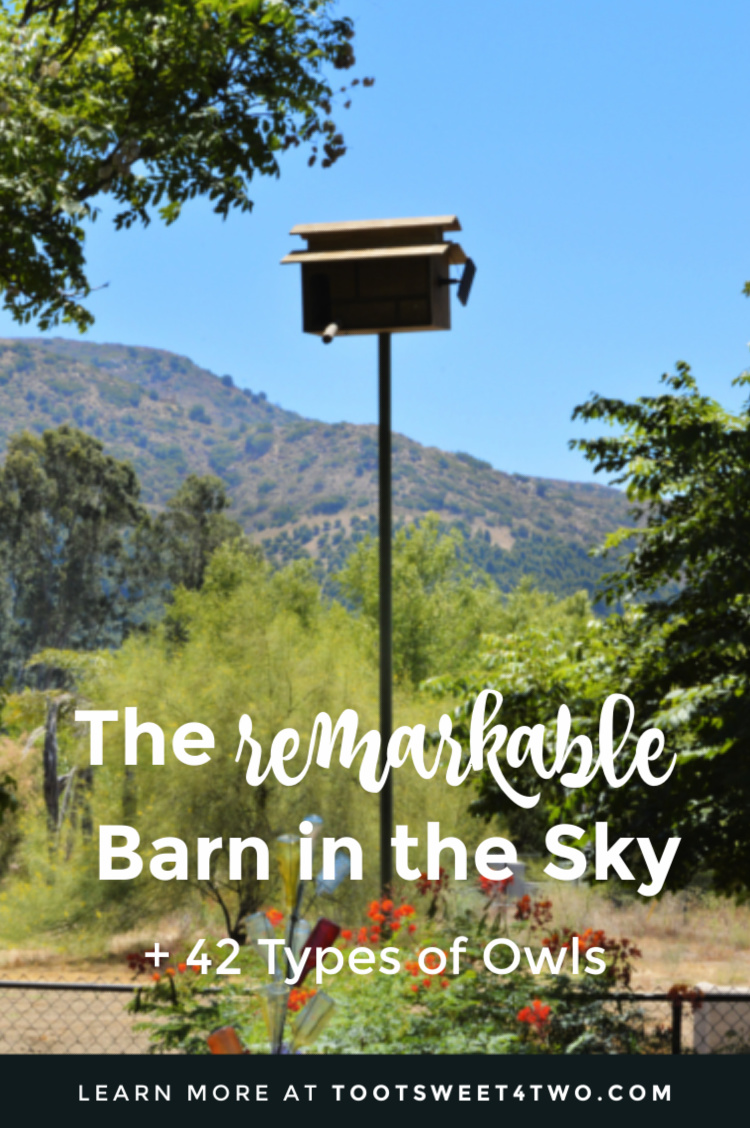
A month earlier, on THE day – that’s right, the VERY day – that this remarkable barn owl nesting box was installed, an owl stopped in. Why do I consider this such a momentous event? Because, according to the guy who installed the owl nesting box for us, nesting season for owls in Southern California is December, and to lower our expectations, he told us not to expect any activity until sometime in the winter months.
It turns out that the owl that originally stopped by that very first day was NOT Barney, but another barn owl, a different barn owl, because, well, he just was! Take a look…
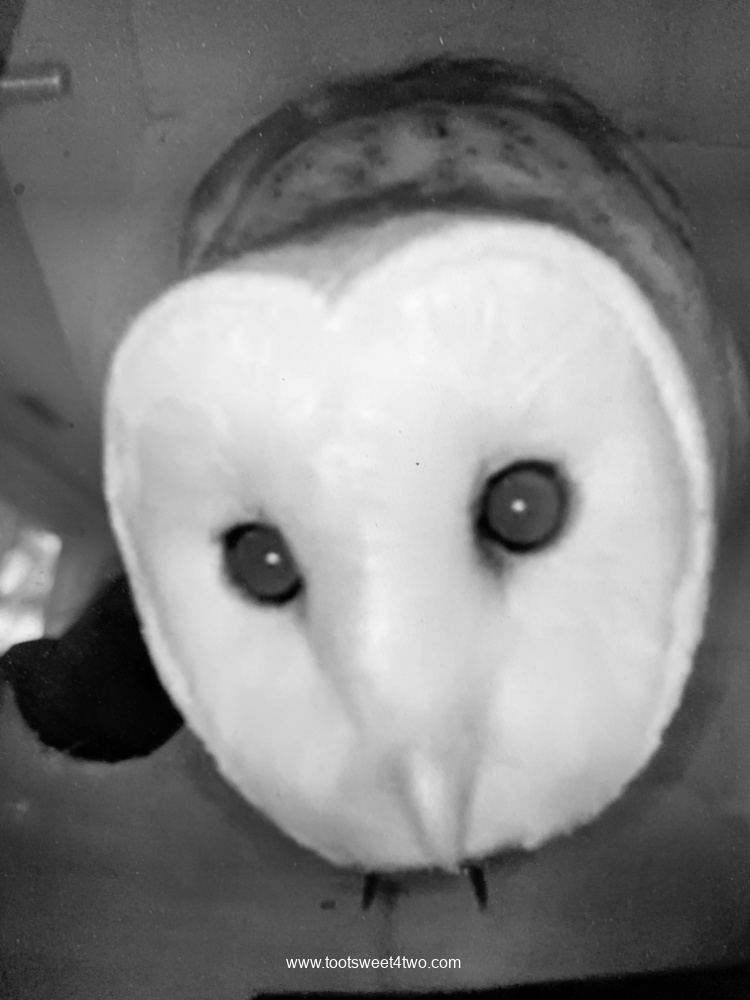
The photo above is of poor-quality because I snapped this on my iPhone from the video that was taken of that night. I don’t know how to create a photo from a video (something else I need to learn – lol). Anyway, this barn owl stared right into the camera bobbing his head from side-to-side, trying to decide if the camera was something to worry about or something to eat! So cute! After a few minutes, he left and flew away never to come back.
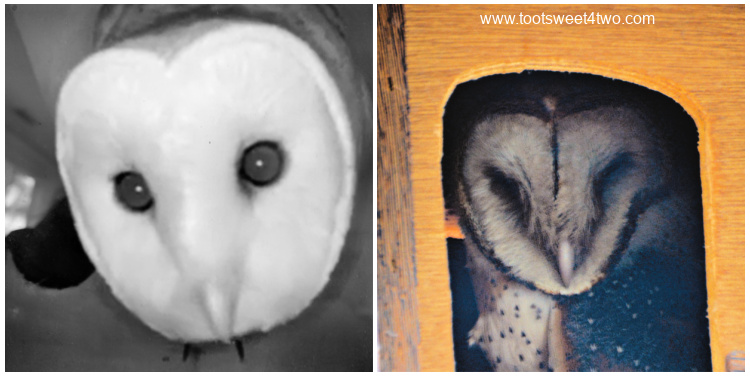
But, he sent Barney instead! Above is a side-by-side comparison of the two owls. Even though the photo on the left is black and white, what is immediately noticeable is that the owl on the right’s facial disc is more heart-shaped plus he has pockets of dark feathers down the middle of his forehead and the corners of his eyes down to his beak. Even their beaks are different shapes.
Interestingly, it was a month to the day that the owl on the left visited, flew the coop, never to return again and the date Barney arrived, decided it was home, and stayed.
How Do I Know What Kind of Owl I Have?
I’m not a barn owl expert by any stretch of the imagination nor an owl expert or even a bird expert. So finding out what kind of owl I have took a bit of research. I’ve learned that there are 216 species of owls around the world and of those species, and within the barn owl family (Tyto alba), there are approximately 35 species and subspecies. Barn owls are located around the world and in North America are classified as Tyto alba pratincola. So, the first step to identifying the kind of owl you have is to find out which kind of owls are native to your area.
Once you know the owls native to your area, look at photos of the different species, eliminating them one-by-one until you’ve come as close as you can to answering your question. For example, I thought I had two different types of owls since they looked so different to me. But, as it turns out, North American Barn Owls look different from one another just like people do! Here’s an example:
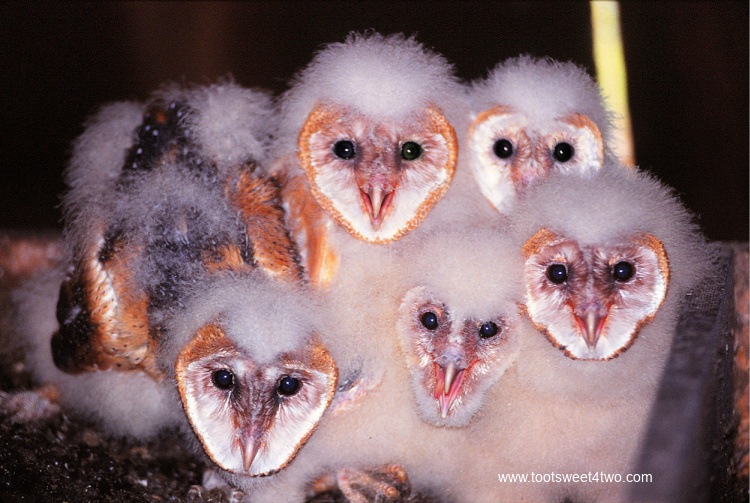
These are baby barn owls in their nest. What I want you to notice about these five baby owl chicks is that every one of their facial discs is different, from the shape of their face to the shading, and feathering, even though they (most likely) have the same parents.
So do I think my two barn owls are siblings? Possibly not. Maybe they are parent and child. Or mates. Or cousins. Or rivals. But, though they look markedly different, they are barn owl of the same species.
References and Resources for 42 Types of Owls
There are many various resources around the web that can help you with your identification process. These are the ones that I used to identify the 42 types of owls in this post:
Xeno-Canto, Sharing Bird Sounds from Around the World
And, the photos that aren’t mine were sourced from a paid stock photo company called 123RF.
Disclosure: This post contains affiliate links for your convenience. Click here to read my full disclosure policy.
Back to the remarkable barn in the sky, aka the owl nesting box…
What makes this barn in the sky so remarkable is the camera inside. It syncs to your phone and every time Barney moves near the camera, it pings letting us know that there is new activity occurring. It also allows you to push a button and take a photo, like this one:

Or, push a different button and record a video, like this one:
Anyway, it pings throughout the day and suddenly I have more than 80 videos of this little guy that we’ve named Barney. Some of the videos aren’t very good because his head is in the way and all you see is the top of his head, so I need to weed them out, but you can see how addicting this camera in the owl box can be! By the way – the camera records in color during the day and switches to black and white during the night via infrared technology.
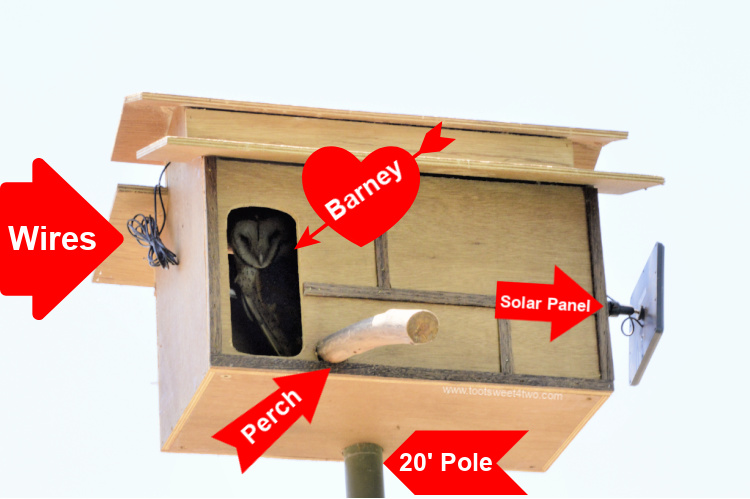
This particular owl nesting box, aka owl barn, is attached to a 20-foot pole set in the ground over a 6-foot post. And the camera is installed inside the box where the red arrow says “Wires.” The camera, an outdoor security camera made by Reolink, comes with the small solar panel, which is mounted on our owl barn to face west. This owl barn came with a perch to make it easier on the owl for take-offs and landings.
If you are the handy type, you can certainly do-it-yourself (links to DIY owl barn info are included at the very bottom of this post). You can build your own owl barn and install the camera (which syncs to your phone) with the solar panel. But if building from scratch is not your thing, you can buy an owl nesting box online, then install the camera and solar panel, and attach the box to a tree or pole. We (Charlie and I) are not the handy type, so we ordered the barn from Tom of Barn Owl Boxes, who with 30,000+ barn owl installations under his belt is your guy on the West Coast.
It is positioned on our property so that I can look out our kitchen window and see it. It gently waves side-to-side depending on the wind conditions, but apparently Barney likes the motion and it helps put him to sleep…like rocking a baby! Here’s a close-up of Barney sleeping in the door…
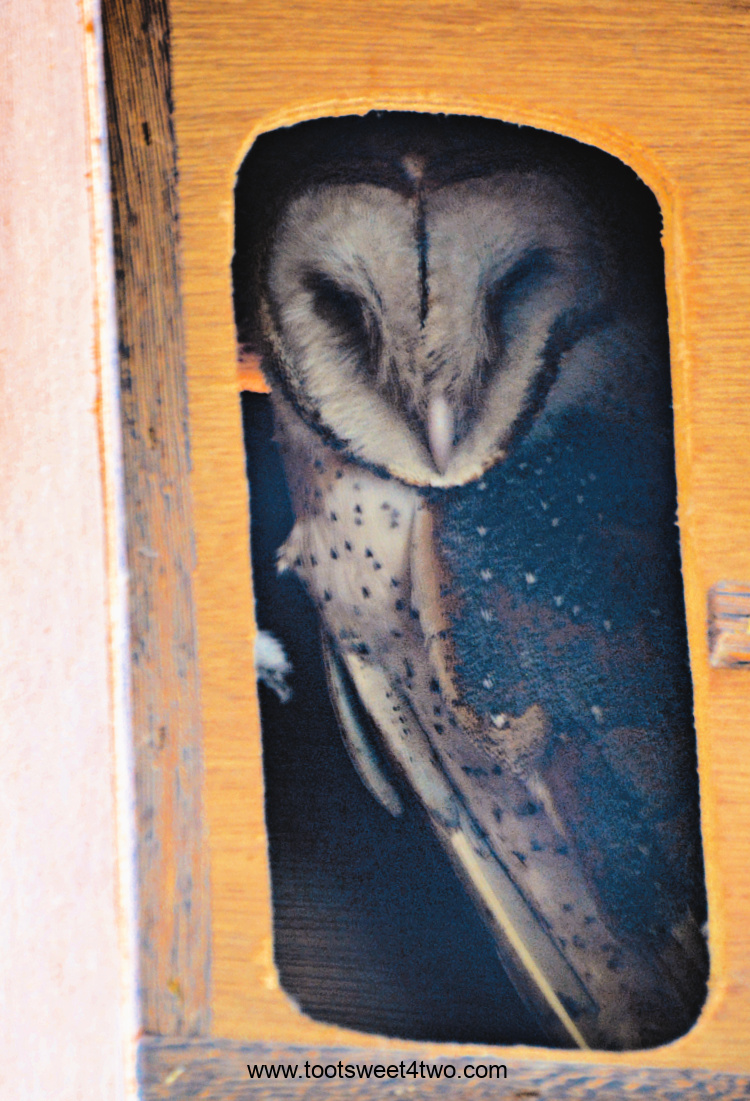
At this moment (the peak of summer), he always sleeps in the doorway. I think the owl barn is probably stuffy from the heat and he likes the cooling breeze that he gets by sleeping in the doorway.
We’ve had an owl nesting box in our gigantic sycamore tree for many, many years. Tom installed that one, too. He shimmied up the tree (in another life he was a tree trimmer) and installed it at least 50 feet up in this giant tree. It is occupied by a pair of barn owls, who we’ve named Oscar and Owlivia Wilde, but sightings are rare (and, it doesn’t have a camera inside).
One day, several years ago, I took a walk out into our field carrying my camera with my telephoto lens attached. As I approached the sycamore tree, I looked up towards the owl box and saw this:
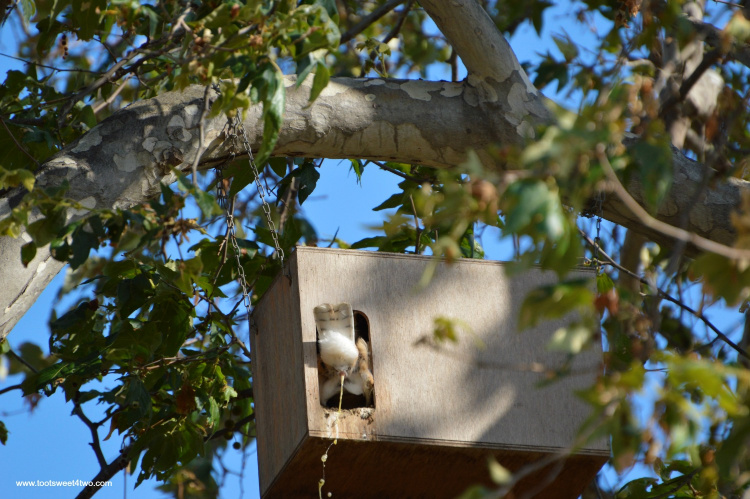
Of course, I wrote a post about this event! I mean, really, how many photos on the internet have you seen of an owl pooping! To say I was surprised and alarmed is an understatement. You can read my story about this unusual owl encounter here: Carole Hears a Whoo.
My Quest for Owl Facts
Now with several owls of my own, I’m on a quest to learn as much as I can about these amazing creatures. Here’s what I’ve learned, in no particular order, posed as questions because I’m awe-inspired by these birds!
- Did you know that there are two main types of owls? The two family branches of owls are Strigidae, the true owl family also known as the typical owl family and Tytonidae, the barn owl family.
- Did you know that there are more than 200 different species and subspecies of owls in the world? Some say 216 owls; other sources say 225 owls, while still other sources say 250 owls! So, let’s just say 200+ owls!
- Did you know that folklore abounds with myth and legends about owls? If you believe the stories, they label owls as harbingers of doom and gloom. I think they’ve just gotten a bad rap throughout the ages.
- Did you know that while normally nocturnal, many different types of owls hunt during the day? Find out which ones below.
- Did you know that owls don’t just hoot, but they whoop, mew, whinny, chuckle, trill, bark, screech, and more?
- Did you know that the vast majority of owls do not build their nests? Depending on the species, they roost in hollowed out tree trunks, abandoned nests made by other species, crevices in cliffs, rocky outcrops, man-made nesting boxes, and more. Find out below which owls build their own nests (here’s a hint – one is white and the other 2 are diggers!).
- Did you know that the female owl is usually larger than the male owl? Upwards of 25% larger in many species.
- What is a group of owls called? I’ll give you a hint – the name of a group of owls is the same as the legislative body in the United Kingdom and a series of buildings along the River Thames. That’s right! A group of owls is called a parliament of owls!
- What is the most beautiful owl? Since beauty is in the eye of the beholder and I think all owls are beautiful, I’ll leave that decision up to you!
- What is the smallest owl in the United States? Hunt for the answer in the types of owls listed below.
- What is the largest owl in the world? Find the answer below!
- What is the rarest type of owl? Search for the answer below!
- How are owls able to fly silently? Not all owls fly silently, but the ones that do have fringed edges on their feathers that muffle the sound of their flight.
- What is the fastest owl in the world? Look for the answer among these 42 types of owls below!
- Did you know that I’ve created an Owl Lovers’ Activity Book just for readers? It’s chockful of super cute things to do with family and friends or just when you are in the mood to color! Check it out…
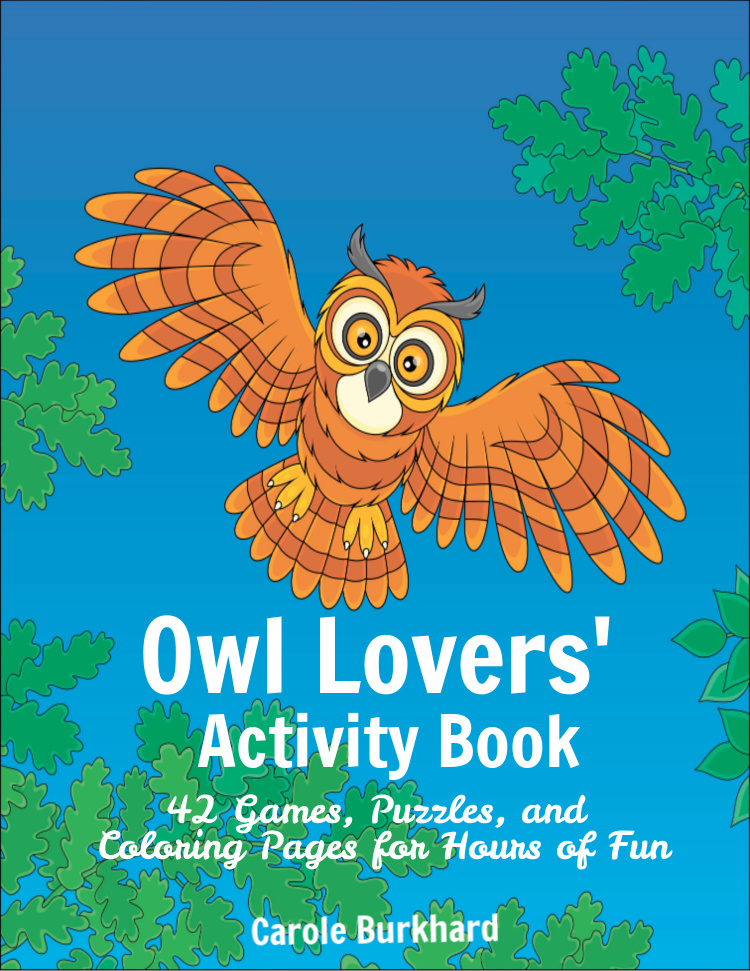
42 Types of Owls with Pictures
Here are 42 types of owls with pictures, from various parts of the world for you to enjoy!
#1 – Common Barn Owl (Tyto alba)
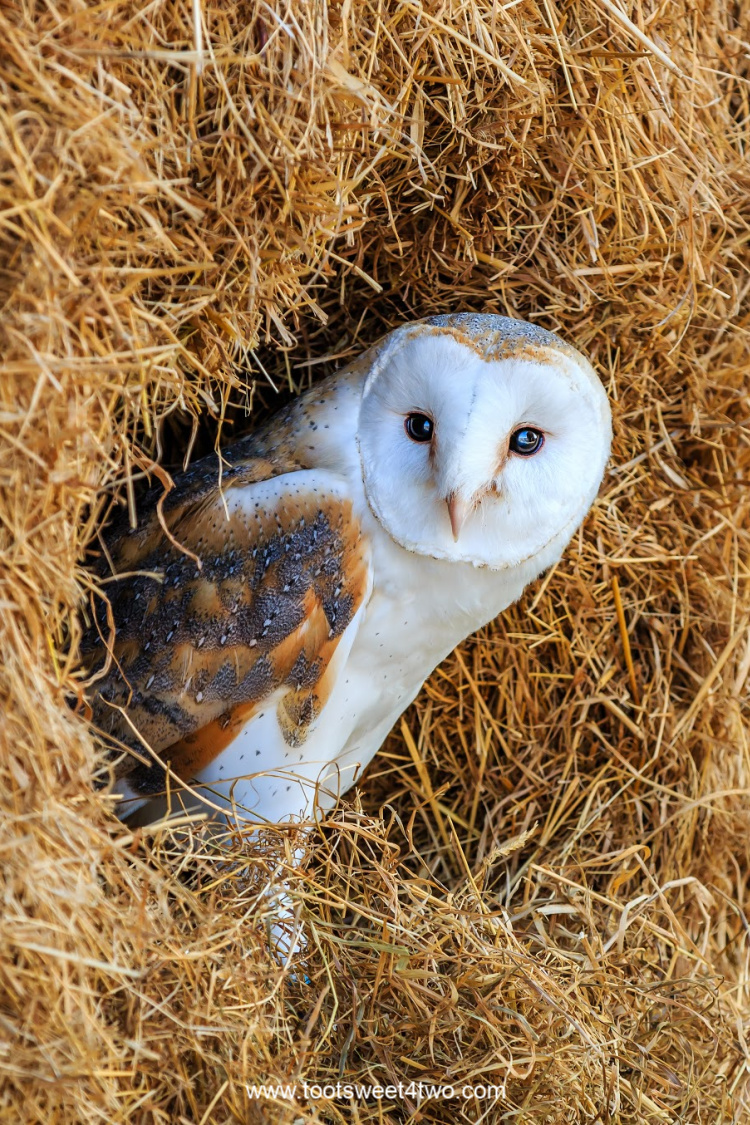
Barn Owls are common across all continents around the world except Antarctica and desert areas. They are distinguished by a heart-shaped face, snowy-white feathered chest, and tawny brown back feathers mottled with black and grey spots. With a length of around 15 inches, this owl usually weighs less than a pound and has a wingspan of approximately 35 inches. They are renowned for having the best ability to locate prey via sound alone, more so than any other owl. As with most owl species, the female is larger than the male and usually weighs more than a pound. The barn owl does not hoot, but screeches. And I can tell you from personal experience that the screech is quite loud and intimidating!
#2 – Flammulated Owl (Psiloscops flammeolus)
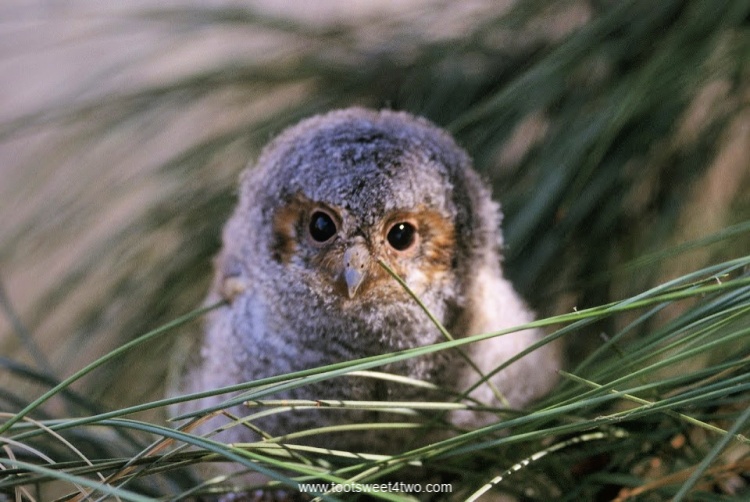
This photo is of a young Flammulated Owl chick, obviously grayish in color. But dark-eyed Flammulated Owls are not only an ash-gray color but reddish as well. A distinguishing characteristic is that their pattern of feathering plumage mimics tree bark, making them easily camouflaged from both prey and predators alike. With a length less than 7 inches and a wingspan of around 15 inches, adults are quite tiny weighing less than 2 ounces. Native to the Western United States, Southwestern Canada, and Mexico, they make a soft hooting, whooping, mewing sound, and eat mostly insects.
#3 – Northern Saw-whet Owl (Aegolius acadicus)
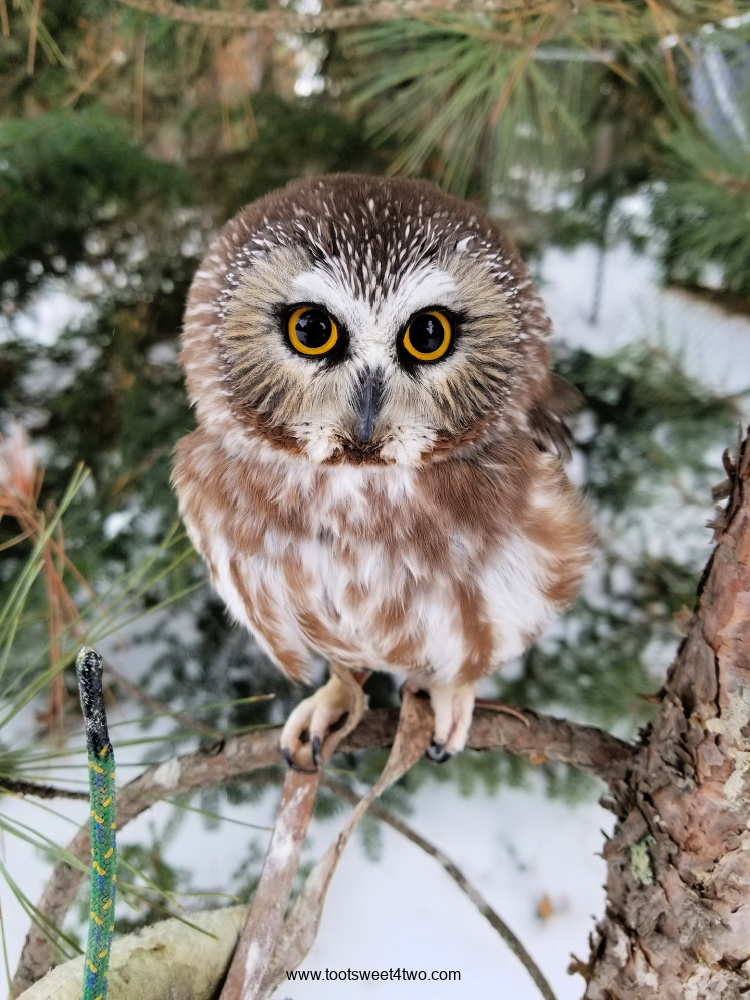
Native to North America and the smallest owl species in America, the Northern Saw-whet Owl gets its name from the eleven various vocalizations it makes including a whistling “swEE” call described as the back-and-forth sound of a whetting saw. This tiny reddish-brown creature also makes a monotonous whistling-type hoop. Small in stature, this owl is no more than 8 inches long, with a wingspan of about 18 inches and only weighs less than a sixth of a pound! With a beautiful round facial disc, the feathers fan out in a circular pattern around two luminous eyes rimmed in gold.
#4 – Eastern Screech Owl (Megascops asio)

This small wonder makes its presence known in a myriad of ways – interestingly, Eastern Screech Owls don’t screech, but whinny, chuckle, trill, purr, hoot, bark, rasp, chatter, hum, and whistle! Under 10 inches in length with a wingspan up to 2 feet, the Eastern Screech Owl has two color variations – red and gray – and weighs about 6 ounces. With short ear tufts and yellow eyes, their habitat is mainly the Eastern United States (east of the Rocky Mountains) encroaching into southeast Canada and northeast Mexico.
#5 – Eurasian Pygmy Owl (Glaucidium passerinum)
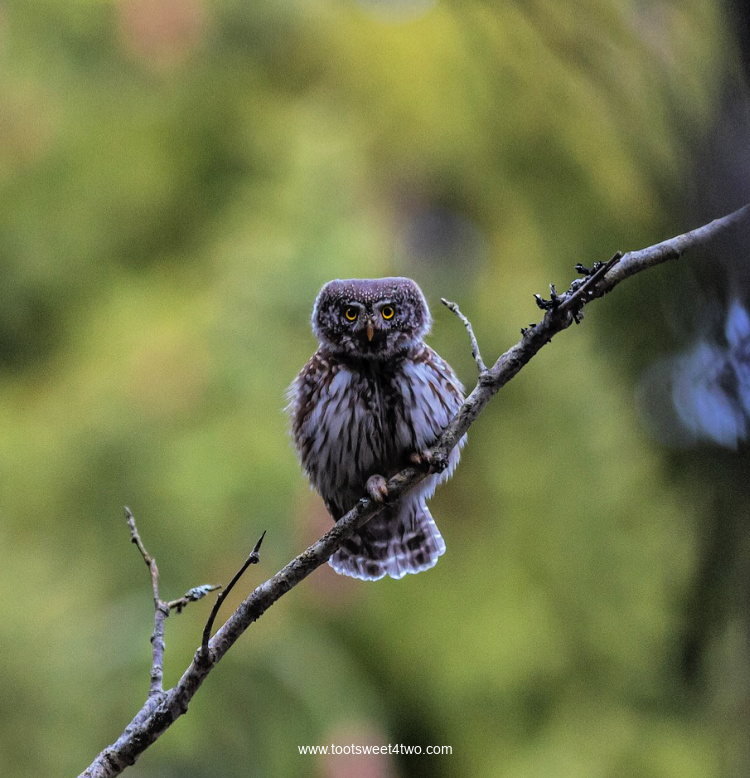
The smallest owl in Europe, the Eurasian Pygmy Owl is found across Central and Northern Europe into Siberia. About 7 inches long, weighing around 2 ounces with a wingspan of a little more than a foot, this tiny little guy has a small, flat-topped head, no ear tufts, and over-sized feet designed to carry larger prey. This owl ranges in color from reddish to grayish and has yellow eyes. They sing to each other in long, shrill whistles that increase in volume and can be heard as far away as three-quarters of a mile!
#6 – Boreal Owl (Aegolius funereus)
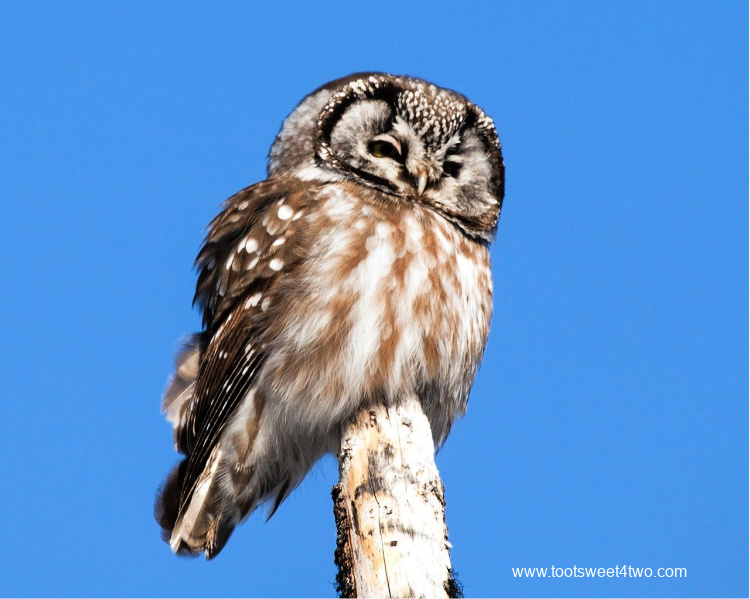
The Boreal Owl is also known under two other names: Tengmalm’s Owl and Richardson’s Owl. Another small owl with no ear tufts, this adorable fluff ball ranges in color from reddish to grayish. About 10 inches long, with a wingspan approaching 2 feet and weighing just over 4 ounces, its habitat ranges from Alaska down through parts of Canada and down through the Rocky Mountain to the top tip of New Mexico. Like the Eurasian Pygmy Owl, their habitat extends across Northern Europe into Asia and Siberia. In this species, the female is usually twice as large as the male. An owl who actually “hoo’s,” this little owl also twills, “kwahks,” and mews.
#7 – Barred Owl (Strix varia)
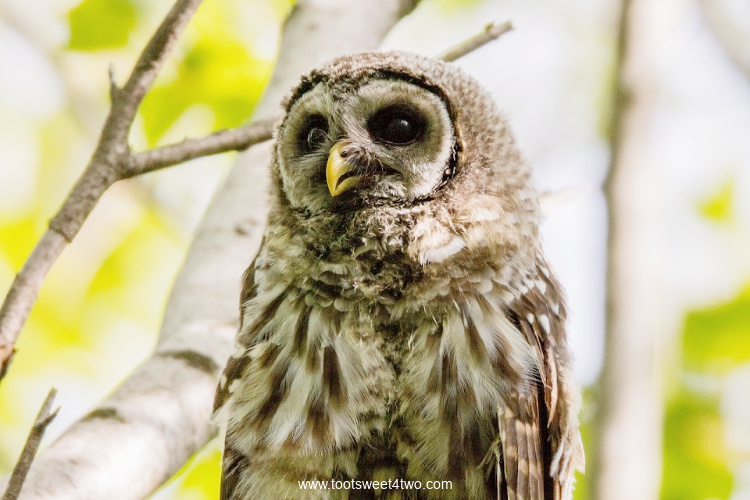
Native to eastern and northwestern North America and number 7 in this list of 42 types of owls, the Barred Owl is also known as the Hoot Owl or the Eight Hooter. A majestic owl of brown and gray, with a rounded head and no ear tufts, the one in the photo above appears to be a juvenile. A large owl between 18 to 25 inches in length, it has a wingspan of about 48 inches and an average weight of a pound and a half (but females weigh up to 2 pounds). This owl actually hoo’s in sets of nine hoo’s described as “Who cooks for you? Who cooks for you all?” – a good storyline for Dr. Seuss! A noisy owl, it also shrieks, cackles, yelps, barks, caws, gurgles, cries, grumbles, trills, and squeals like a monkey. Here’s an interesting fact: Barred Owls swallow their prey whole!
#8 – Mexican Spotted Owl (Strix occidentalis lucida)
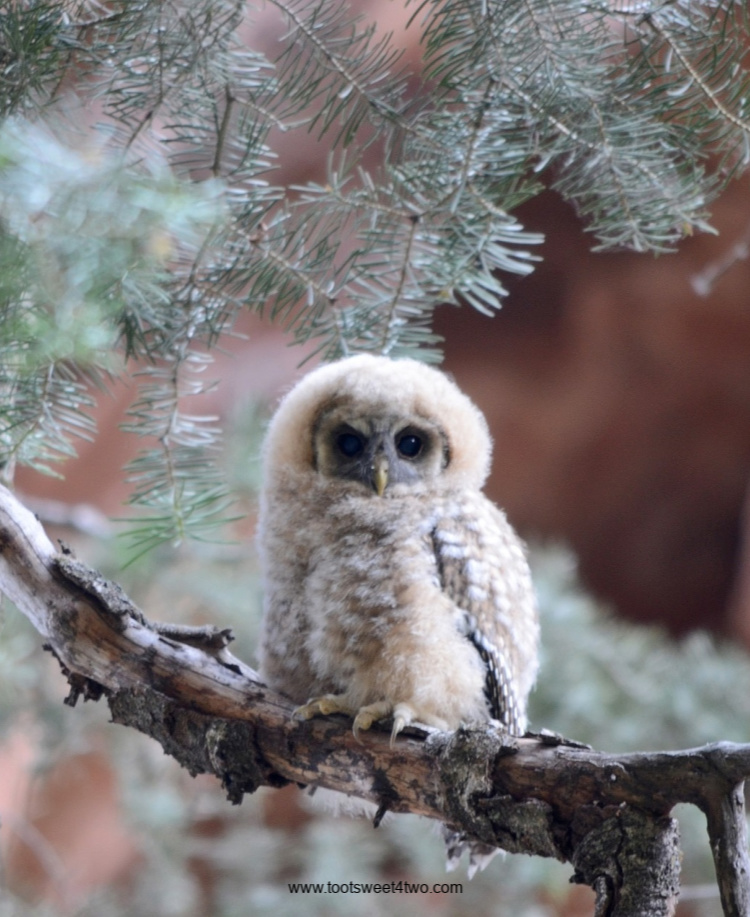
The adorable Mexican Spotted Owl in the photo above is actually an owlet, i.e., a baby chick or nestling in owl-speak. One of the largest species of owls in North America, they are about 18 inches in length, weigh as much as a pound and a half, and have a wingspan of around 42 inches. With dark eyes, brown feathers with white spots, they are considered threatened as a species. While their range of distribution is noted in the United States (primarily Arizona, New Mexico, Colorado, and Utah), little is known about their range in Mexico.
#9 – Eurasian Eagle-Owl (Bubo bubo)
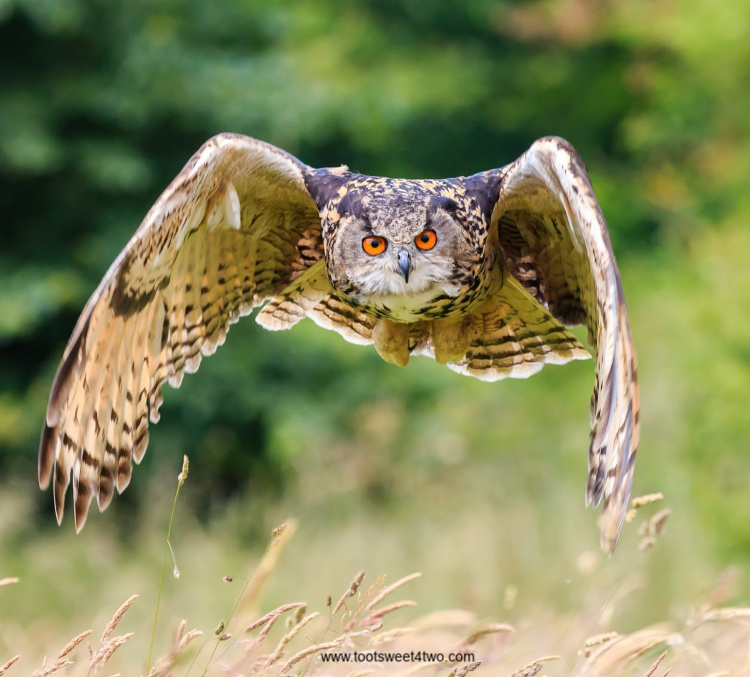
Also known as the European Eagle Owl, the Eurasian Eagle Owl is native to that part of the world. With bright orange eyes, this owl is the fastest owl in the world and one of the largest. With a wingspan that often exceeds 6 feet and a length of around 26 inches, these massive owls weigh up to 10 pounds (females, of course!). With a tawny underside mottled with dark brown spots, this beautiful owl sings oohu-oohu-oohu unless threatened, and then it barks and even growls! Not picky eaters when it comes to prey, over six hundred different species of birds and animals have been identified as part of their diet. They can even swallow a rabbit whole! Fun Owl Fact: Eurasian Eagle Owls have been known to live more than 60 years in captivity.
#10 – Ural Owl (Strix uralensis)
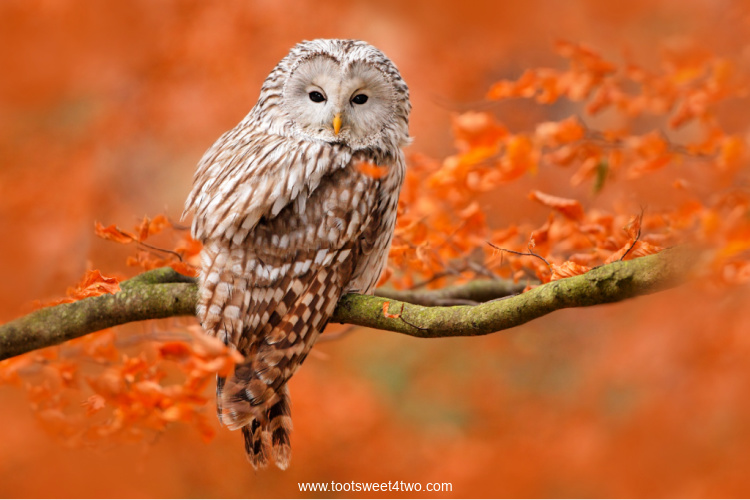
Named after the Ural Mountains of Russia, the Ural Owl’s range extends across Eastern Europe encroaching into Central Europe in forested areas. With a longer tail than most owls, the Ural Owl is around 2 feet in length with a wingspan of around 4 feet. A large owl, though not the largest, they typically weigh between 2 to 3 pounds, with females weighing more than males. Quieter than most owl species, they often go a much as two days without making a sound! Imagine not talking for two days!
#11 – Eurasian Tawny Owl (Strix aluco)
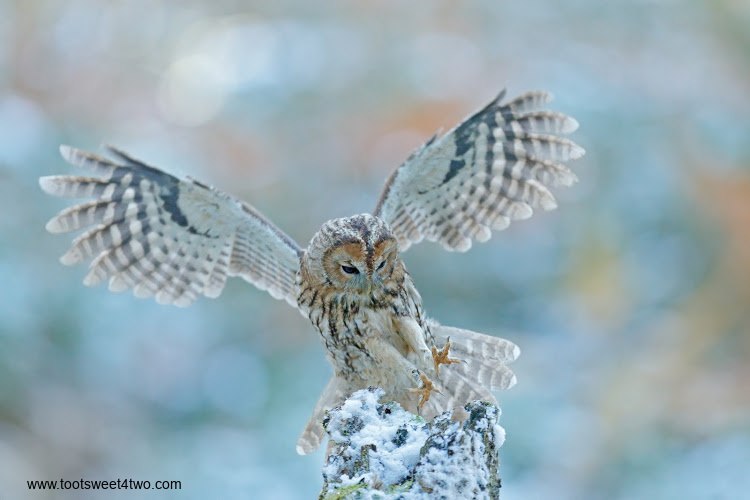
Three different color variations are prominent in the Eurasian Tawny Owl – either grey, brown, and rust (rufous) plumage, with under-feathers that are tawny-buff (like the one above) or tawny-chestnut. With large dark eyes, this beautiful owl is of medium size, and, as with most owls, the female is notably larger. They average about 16 inches in length, weigh around a pound, and have a wingspan of approximately 3 feet. Their range is most of Europe, parts of North Africa, spreading east into Western Siberia, northeasternmost China, into India and other countries with large gaps between distribution (so, in plainer English – scattered here and there and everywhere across Europe, Asia, and Africa; i.e., in other words, they get around!).
#12 – Spectacled Owl (Pulsatrix perspicillata)
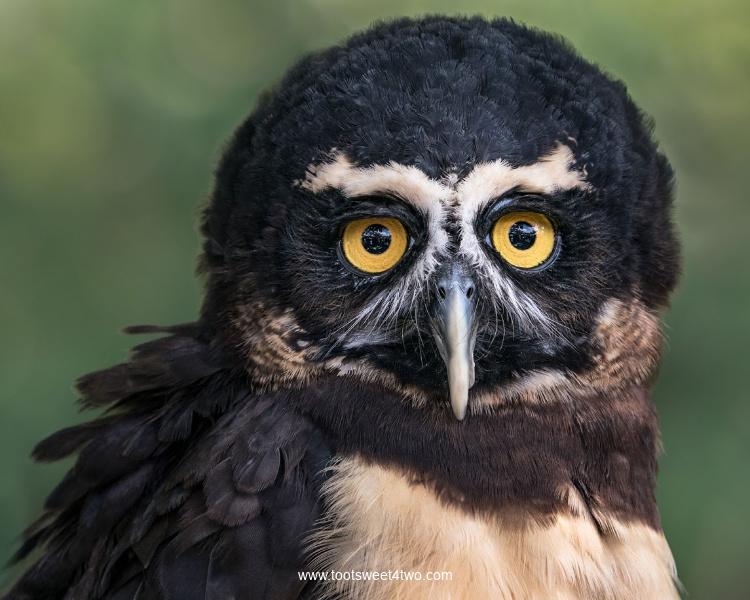
With a dark face framed in white facial markings, the Spectacled Owl appears to be wearing glasses. Do you think this owl gives rise to the cartoonish “wise owl” associated with academia? With large golden eyes, this large owl measures around 18 inches in length, weighs anywhere from one to two and three-quarters pounds and has a wingspan of approximately 30 inches. Occupying tropical rainforests, Spectacled Owls are native to Mexico, Central America, the northern part of South America, and the islands of Trinidad and Tobago. The Spectacled Owl doesn’t hoot – it makes guttural knocking, tapping, and popping sounds.
#13 – Short-eared Owl (Asio flammeus)
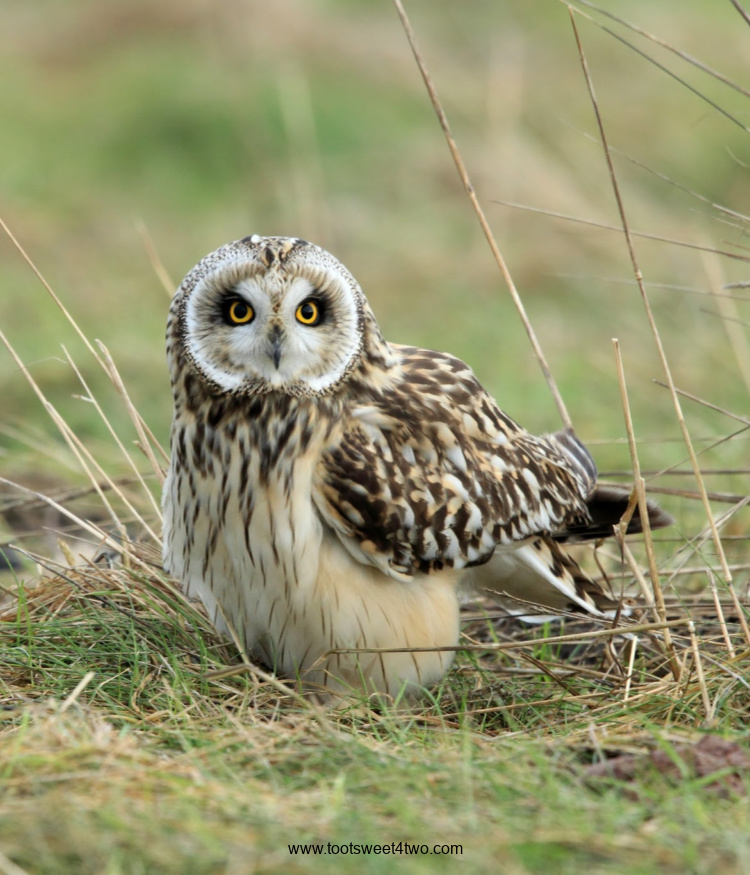
Commonly found in daylight hours, the Short-eared Owl is also known as the Grass Owl and can be found around the world except in Australia and the Antarctic. Weighing less than a pound (females can weigh more), this sweet little thing is about fourteen and a half inches in length with a wingspan of about 38 inches and has yellow eyes ringed in black. Indigenous to open landscape, grasslands, marshes, etc., they nest on the ground by digging a hole in the dirt and covering it with grassy materials and feathers. Their many vocalizations include hoos, barks, hisses, squawks, and toot-toot-toot-toots!
#14 – Great Gray Owl (Strix nebulosa)
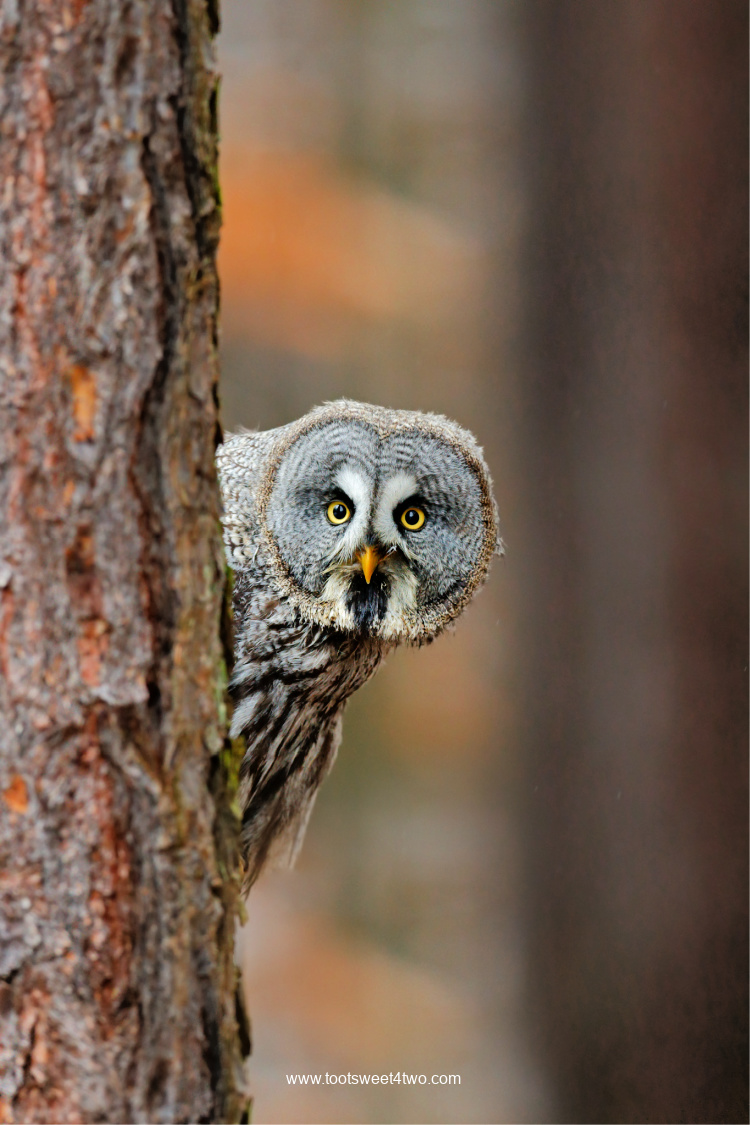
With a wingspan of more than 5 feet, the Great Gray Owl (also commonly spelled Grey), is one of the largest in the United States and Canada weighing up to 4 pounds with an average length of 28 inches. Sporting a large head, this beautiful owl is grayish-brown in color with large yellow eyes and fluffy plumage that belie it’s smaller body structure hiding underneath. They are also known by several other names – Dark Wood Owl, Lapland Owl, Striped Owl, Lapp Striped Owl, Phantom of the North, Cinereous Owl, Spectral Owl, Spruce Owl, Bearded Owl, and Sooty Owl – talk about confusing!
#15 – Elf Owl (Micrathene whitney)
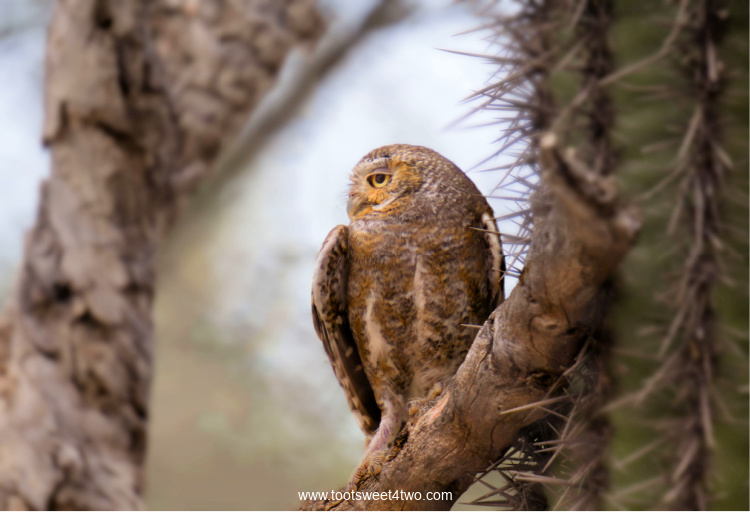
Also known as Whitney’s Owl and Dwarf Owl, the Elf Owl is the smallest and lightest owl in the world weighing less than an ounce and a half. Only 5 inches in length, this diminutive owl has a wingspan of about 10 inches and is about the size of a sparrow. Native to the desert areas of the American Southwest, Baja California, and down through Central Mexico, these tiny creatures typically nest in abandoned hardwood tree cavities and cacti hollowed by woodpeckers. Active at dusk and just before dawn, Elf Owls call to each other by yipping (think of the sound of a puppy), chuckling, and whinnying.
#16 – Great Horned Owl (Bubo virginianus)
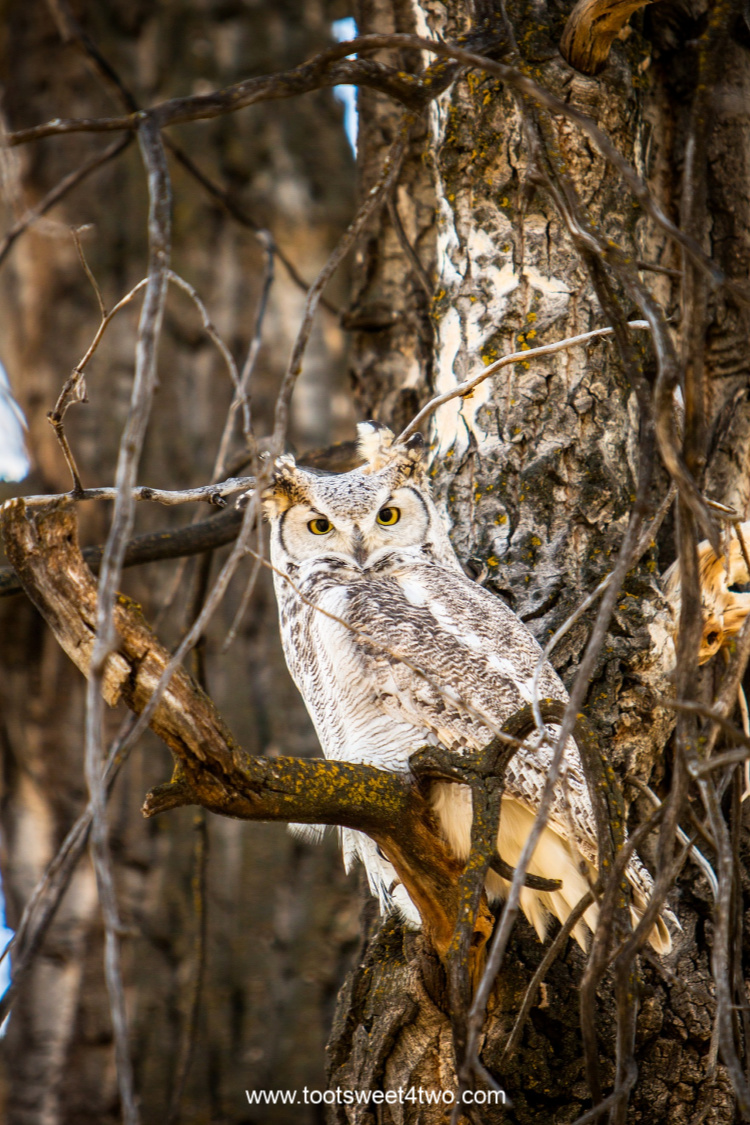
Named for the long tousled, feathered ear tufts called plumicorns that looked like horns, the Great Horned Owl is native to North America and Central America as well as parts of South America. They are also known as the Tiger Owl, Winged Tiger, Tiger of the Air, and Hoot Owl. With bright yellow eyes and a black beak, these large, stocky owls are around 22 inches in length, weighing an average of 3 pounds, and have a wingspan of approximately 4 feet. With a wide variety of vocalizations, their main territorial call is the classic hoo-hoos or who, whoo-hoo, etc. But, they make other sounds like shrieks, hoots, barks, coos, chuckles, squawks, screeches, screams, meows, and more, depending on whether or not they perceive a threat or are just calling their mates. Not very picky about their diet, Great Horned Owls prey on other owls, falcons, other birds, reptiles, fish, frogs, large insects, and lots of different small animals, some 2 to 3 times their size!
#17 – Burrowing Owl (Athene cunicularia)
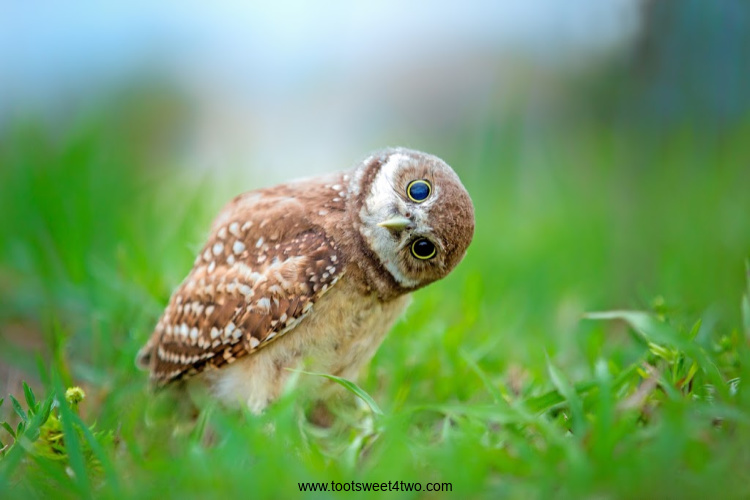
Did you know that owls can rotate their heads and necks up to 270 degrees? Look at this little guy scoping out his photographer! So cute! Burrowing Owls live underground and hunt on the ground during the day, typically at dusk and dawn, making them easier to spot than most owls who are nocturnal. Known by several other names – Ground Owl, Prairie Dog Owl, Gopher Owl, and Cuckoo Owl – I’m sure the Cuckoo Owl name refers to their vocalizations, which are cuckoo, or cu-cuhooh, unless they are frightened and then they go crazy making all kinds of high-pitched sounds. Native to western and central North America, Central America, and a large part of South America, these tiny creatures weigh approximately 5 ounces, are about 8 inches in length, and have a wingspan around 20 inches. Here’s a video from San Diego Zoo Global about their conservation efforts in San Diego County: Saving the Burrowing Owl. And here’s a cute page full of Burrowing Owl facts put together by the team at San Diego Zoo Kids.
#18 – Spotted Wood Owl (Strix seloputo)
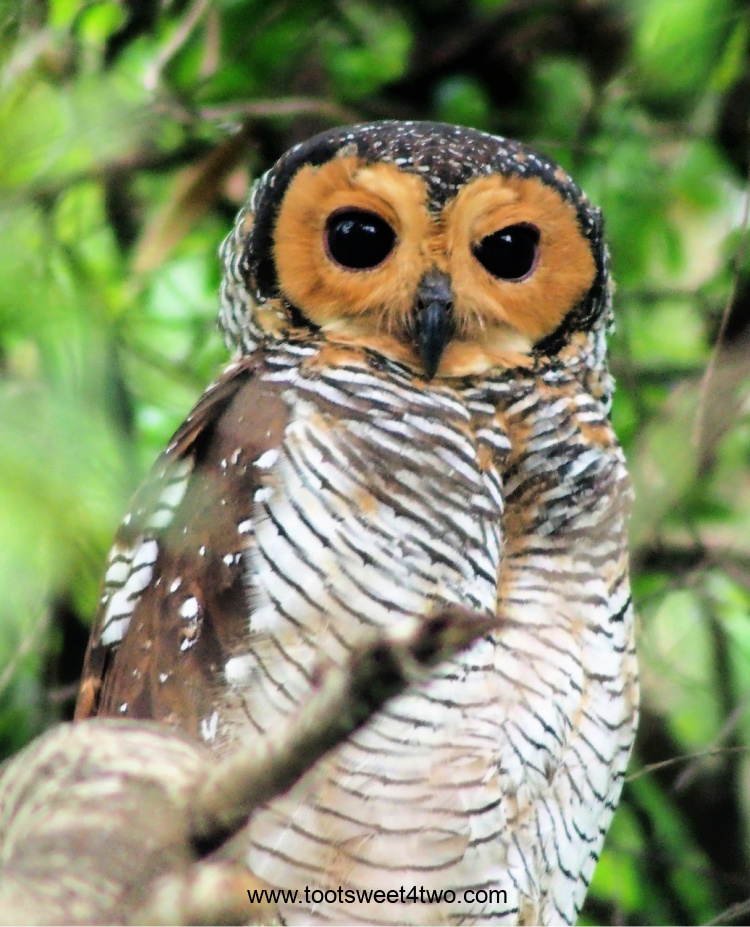
With a golden-orange facial disc, haunting dark eyes, and a black-and-white barred/banded chest, this beautiful owl is native to Southeast Asia and some of the nearby islands. Around 18 inches in length, the Spotted Wood Owl is medium-sized owl weighs around 2 pounds and has a wingspan around 30 inches. As with most owl species, the female is larger than the male and their beaks are described as greenish-black. Roosting in forests, they huhuhu and whoo and even hoot.
#19 – Southern White-faced Owl (Ptilopsis granti)
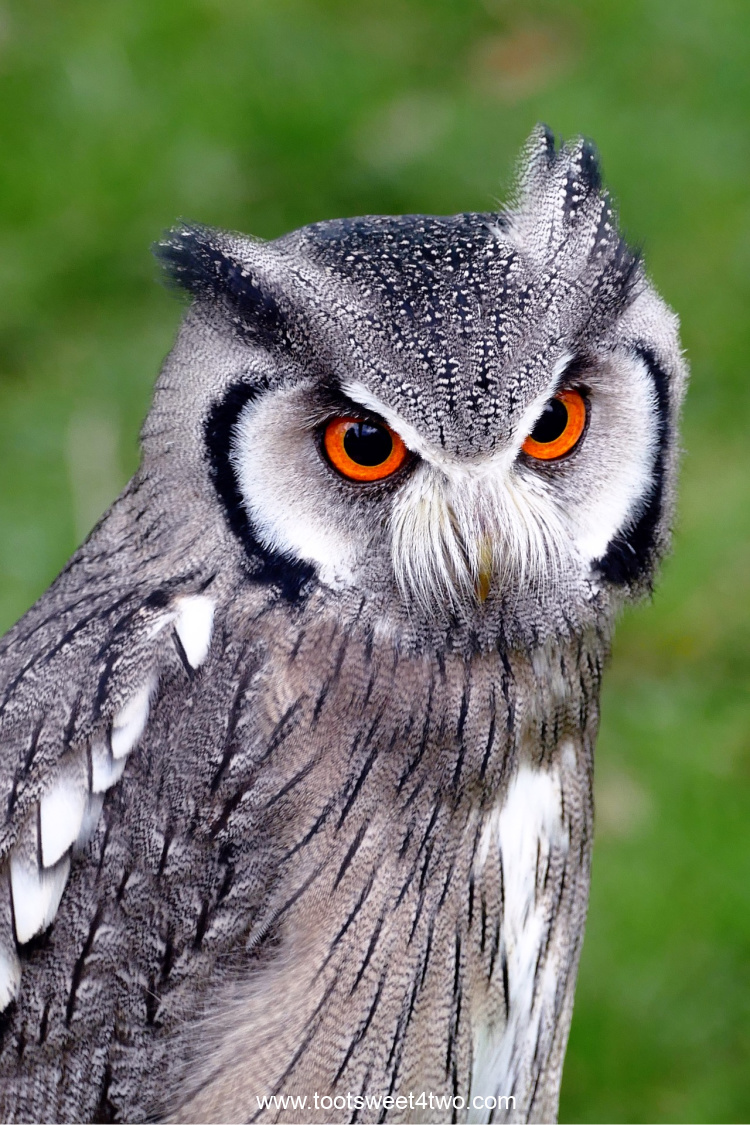
Also known as Southern White-faced Scops Owl or White-faced Owl, the Southern White-faced Owl is native to the southern half of the African continent preferring to live in the open savanna among the scattered trees and in dry open woods. A small owl, they weigh about 7 ounces, average 8 inches long, and have a wingspan of approximately 15 inches. Easy to identify with their white facial disc, they have fiery orange-red eyes and a feathery tuft between their eyes that make them look like Groucho Marx! The main distinguishable difference between the Southern White-faced Owl and Northern White-faced Owl (except maybe DNA) is their color – the Southern white-faced Owl is gray while the Northern White-faced Owl is paler and can be shades of brown. This is another owl who hoots!
#20 – Verreaux’s Eagle Owl (Bubo lacteus)
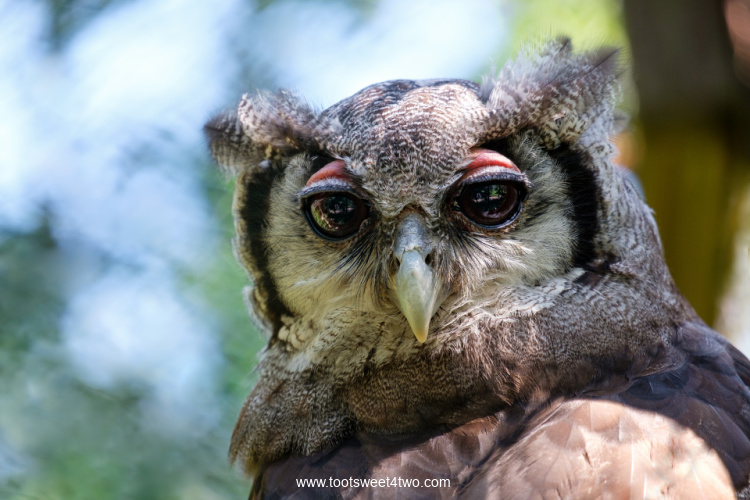
Native to sub-Saharan Africa roosting in dry, wooded savannas, the Verreaux’s Eagle Owl is also known as the Milky Eagle Owl or Giant Eagle Owl. One of the largest owls in the world, they range in weight from 4 to 7 pounds (the female in the 7-pound range) with a length averaging 26 inches and a wingspan that’s been recorded between 4 1/2 feet to 6 feet. They are easily distinguishable by their pink eyelids, which are unique to them and no other owl in the world, framing very dark brown bulging eyes! With a uniform plumage of mainly pale gray, they also can be a pale reddish-brown in color. They are considered to have the deepest call in the world, which sounds like a grunting gwonk, gwok–gwok, etc., and the female whistles for food (females whistle to males during nesting). With a propensity for hedgehogs, their diet is a random selection of rodents, birds, primates (think monkeys, mongoose, and meerkats), reptiles, and even large insects.
#21 – Northern White-faced Owl (Ptilopsis leucotis)
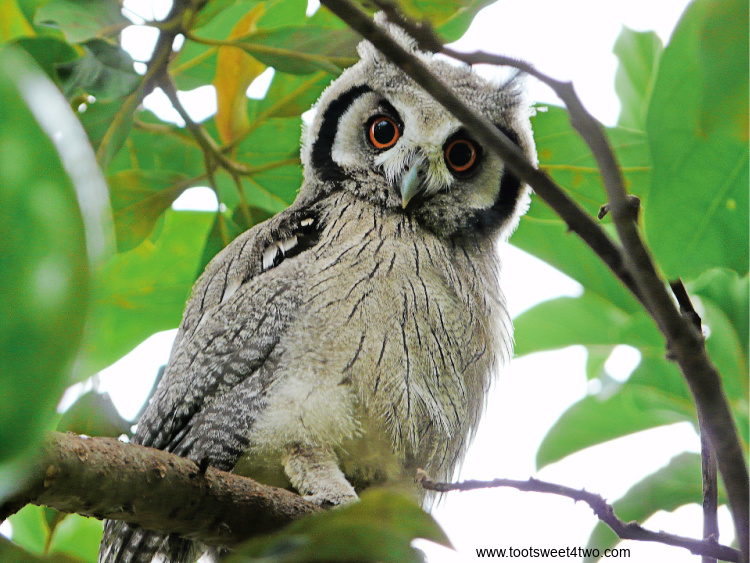
Formerly known as the White-faced Scops Owl collectively along with the Southern White-faced Owl (#19 above), the Northern White-faced Owl is very similar to the Southern White-faced Owl – so similar that I can’t tell the difference! The only distinguishing difference I have been able to find as a visual reference is that the Northern White-faced Owl has “reduced streaking” down their front chest feathers! Such cute owls, don’t you think? Almost a Panda-like quality in their cute faces. I suppose, too, that their difference might live in their DNA, but I can’t find any reference to that. Anyway, they, too, are small owls weighing around 7 ounces, with a length of about 9 inches, and a wingspan of approximately 15 inches. And, like the Southern White-faced Owl, they are native to Africa in an area stretching from coast to coast across Africa, between the Sahara desert and the Equator.
#22 – Pharaoh Eagle Owl (Bubo ascalaphus)
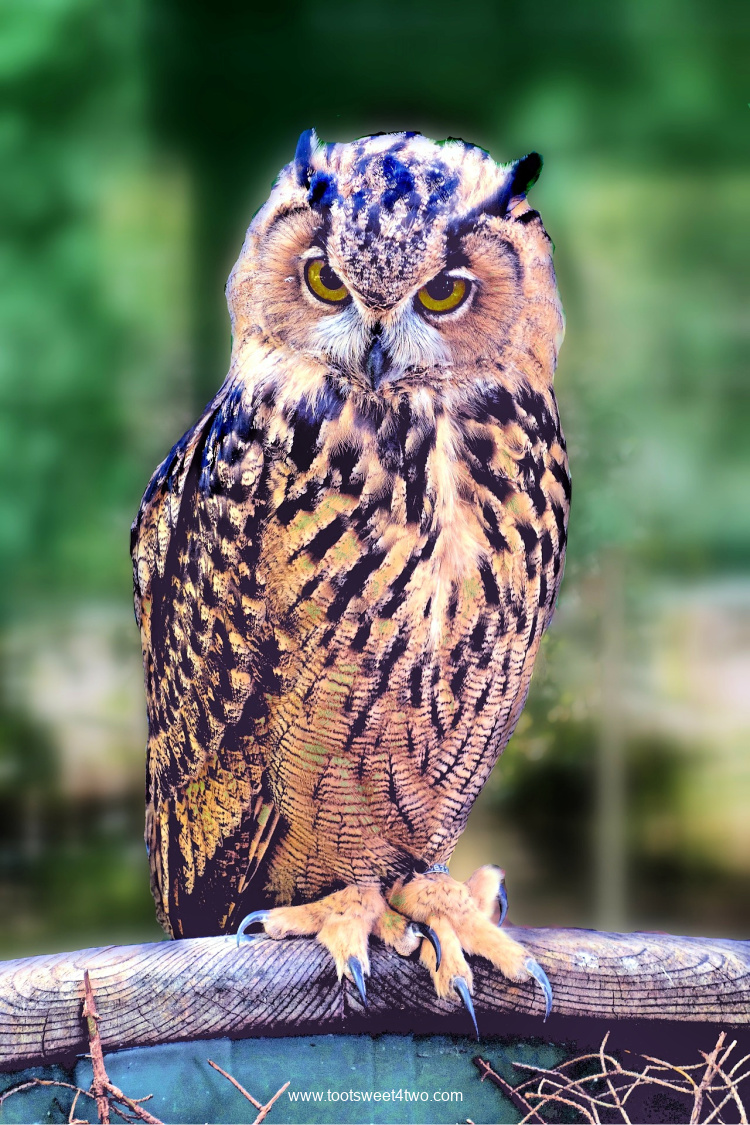
The regal-looking Pharaoh Eagle Owl is a majestic owl with streaky mottled tawny brown plumage and bright golden-yellow eyes. Native to sections of Northeast Africa and parts of the Arabian peninsula, this owl nests in rocky outcrops, cliff crevices, and cave entrances in the semi-desert landscape it inhabits. Although a large owl, the Pharaoh Eagle Owl is considered one of the smallest of eagle owls at 20 inches long, approaching 5 pounds in weight with an average wingspan of 30 inches. Hunting a variety of prey, they target small mammals, birds, rodents, and more.
#23 – Long-eared Owl (Asio otus)
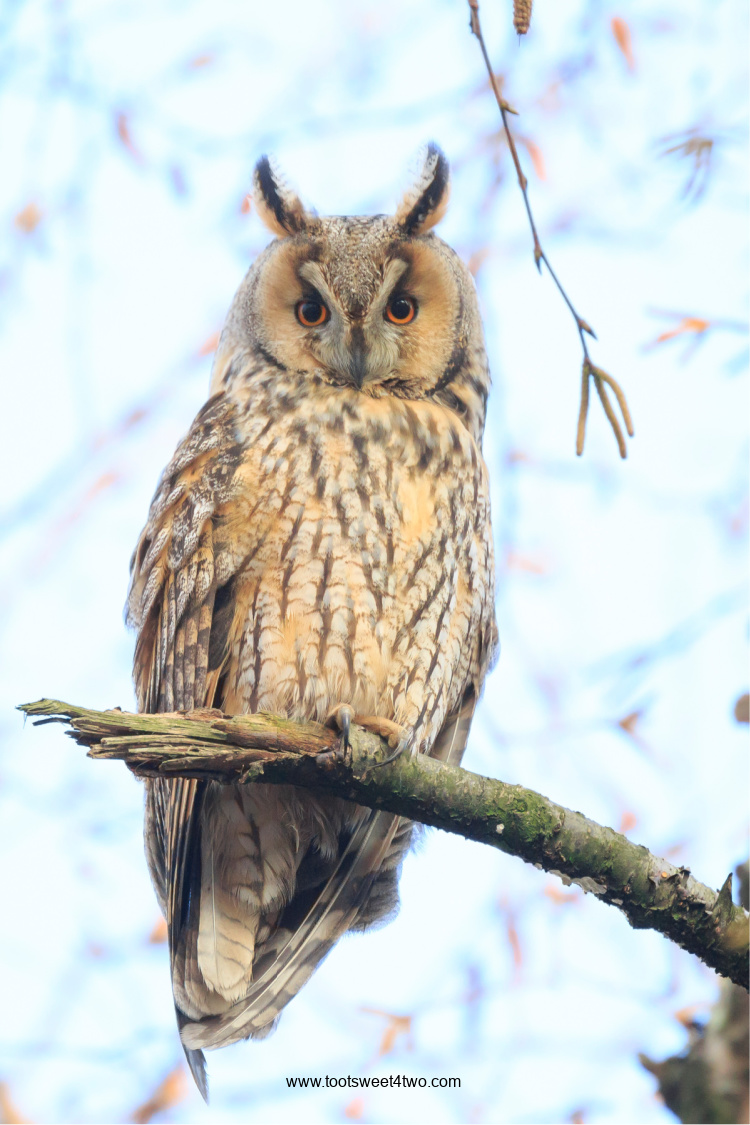
The Long-eared Owl, also known as the Common Long-eared Owl, Lesser Horned Owl, Cat Owl, and Northern Long-eared Owl, is so named because, well, it has long ears! In owls, these ears are called ear tufts and in the case of the Long-eared Owl, these ear tufts are erect and located towards the center of this medium-sized owl’s head giving this owl the appearance of being bigger than it is. Slender, the Long-eared Owl is about 15 inches in length, weighing around 10 ounces, with a wingspan of 3 feet. Coloring varies but always includes various shades of mottling from buff to tawny to brownish-red to gray, and they have luminous rusty-orange eyes. Native to North America, Europe, and Asia, this owl likes to roost in thick brushy areas, and during winter, they nest together (communally), sometimes in large groups of 20 or more (as many as 50 have been recorded together).
#24 – Western Siberian Eagle Owl (Bubo bubo sibiricus)
A subspecies of the Eurasian Eagle Owl, the Western Siberian Eagle Owls’ territory extends from the western foothills of the Ural Mountains in Siberia to the valley of the Ob River in the east. Paler in color than Eurasian Eagle Owls, the plumage of these majestic owls runs the gamut of snowy white (like Snowy Owls, but not quite as white) to buffy off-white to tawny-buff. Easily confused with the Eastern Siberian Eagle Owl (Bubo bubo yenisseensis), these beautiful owls weigh around 7 pounds, are about 18 inches in length with an approximate wingspan of 5 to 6 feet. They tend to hunt larger animals and birds as prey.
#25 – Chaco Owl (Strix chacoensis)
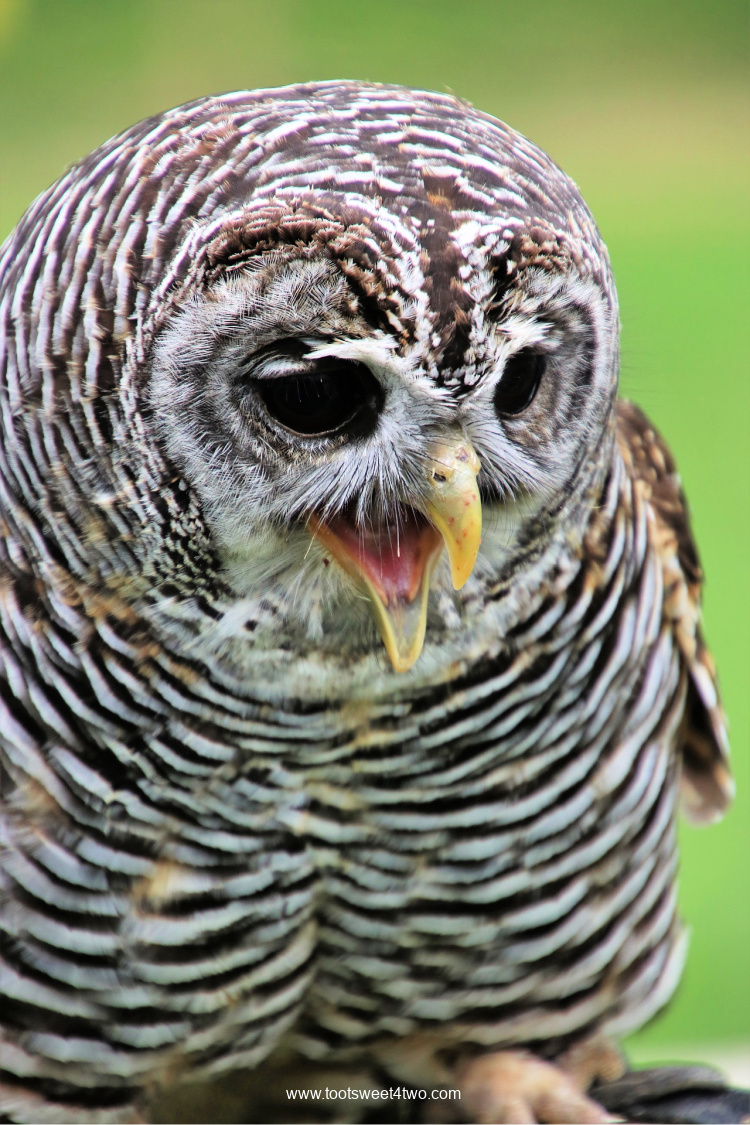
Native to specific parts of South America (southern Bolivia, western Paraguay, northern Argentina), the Chaco Owl is rare and considered near threatened. Medium-sized, this heavily barred (striped) owl is about 15 inches in length with a wingspan of 30 inches and weighs approximately 12 ounces. It lives in hilly areas with rolling hills, flatlands with splotches of trees, open forests, and it preys on small mammals, small birds, and insects.
#26 – Western Screech Owl (Megascops kennicotti)
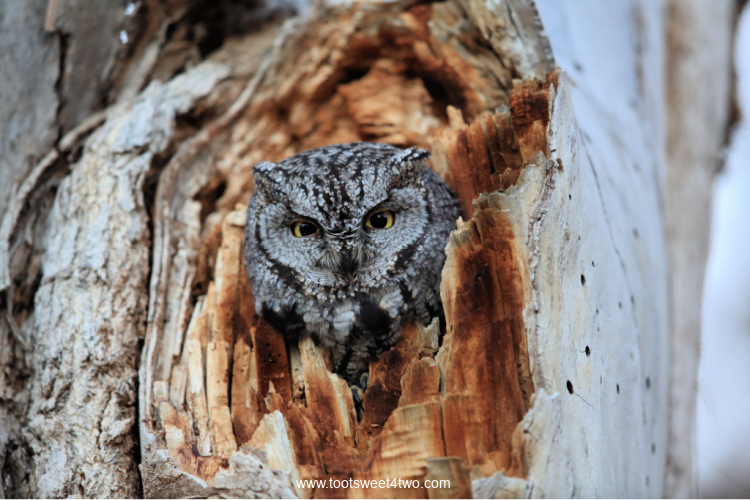
With plumage reminiscent of tree bark, the Western Screech Owl is thoroughly camouflaged. A small, gray owl with yellow eyes, this tiny owl is native to western North and Central America and is also known as Kennicott’s Screech Owl and Vinaceous Screech Owl. Though small in stature, the Western Screech Owl often preys on critters much larger than themselves. Interestingly the Western Screech Owl does not screech, but hoots and trills instead. These little guys weigh about 5 ounces and are approximately 9 inches in length with a 2-foot wingspan.
#27 – Australian Boobook Owl (Ninox boobook)
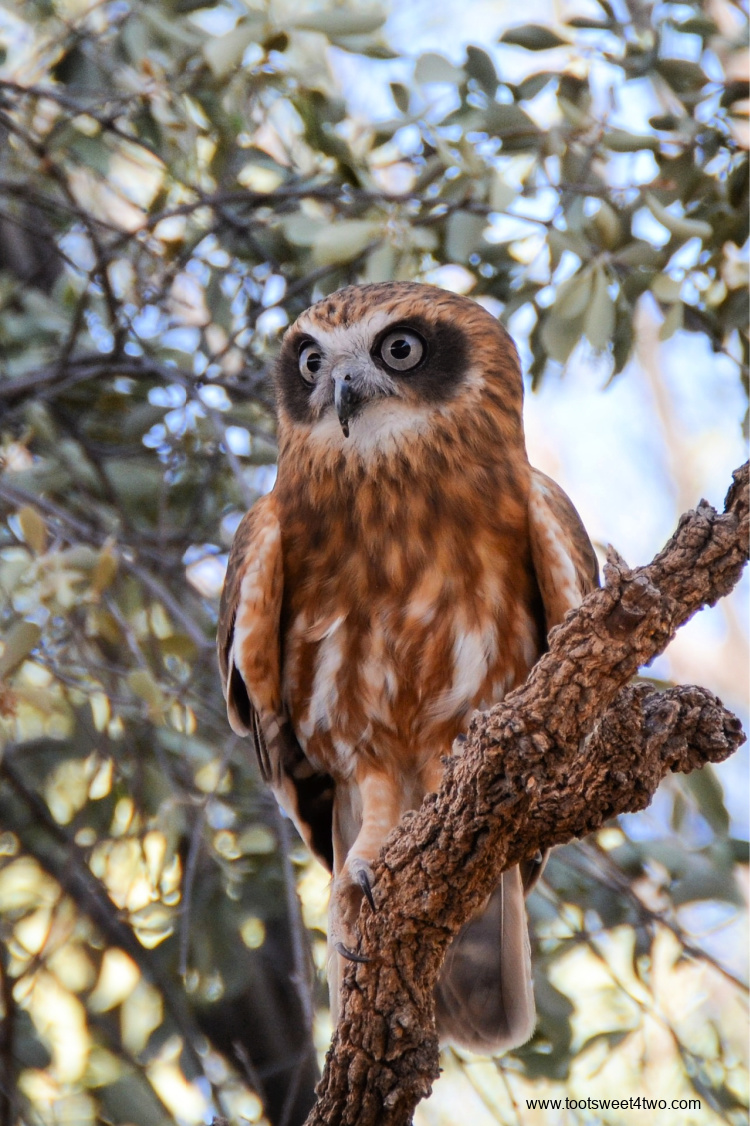
Also known as the Southern Boobook Owl and the Spotted Hawk Owl, the Australian Boobook is native to Australia and named because of its unique boo-book song. With color variations from brown to gray to red, this medium-sized owl has distinctive dark patches around each eye and a hawk-like appearance. The smallest owl on Australia’s mainland, it weighs about 8 ounces, is around 12 inches in length with a wingspan of approximately 20 inches. Another distinguishing feature is their eyes – either gray-green as in the photo above or yellow-green. Preferring habitat areas full of scattered trees, their range is all of Australia adapting even to arid desert landscapes although they prefer forests of eucalyptus trees.
#28 – Pearl-spotted Owlet (Glaucidium perlatum)
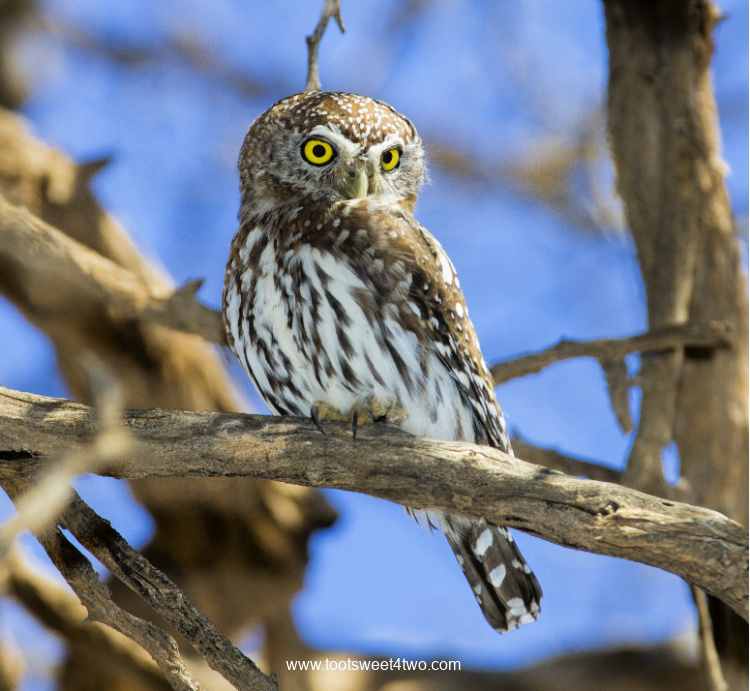
With pearl-like spots covering its shoulders and head, the tiny Pearl-spotted Owlet is well named. With prominent white eyebrows and yellow eyes, the Pearl-spotted Owlet weighs about five ounces, has a length of about seven inches, and a separate longish tail length of three inches. With a wingspan of about twelve inches, this little owl is often mobbed by other small birds because it hunts during the day. Native to Sub-Saharan African, it nests in open woodland and savanna disliking rainforests and deserts.
#29 – Northern Hawk Owl (Surnia ulula)
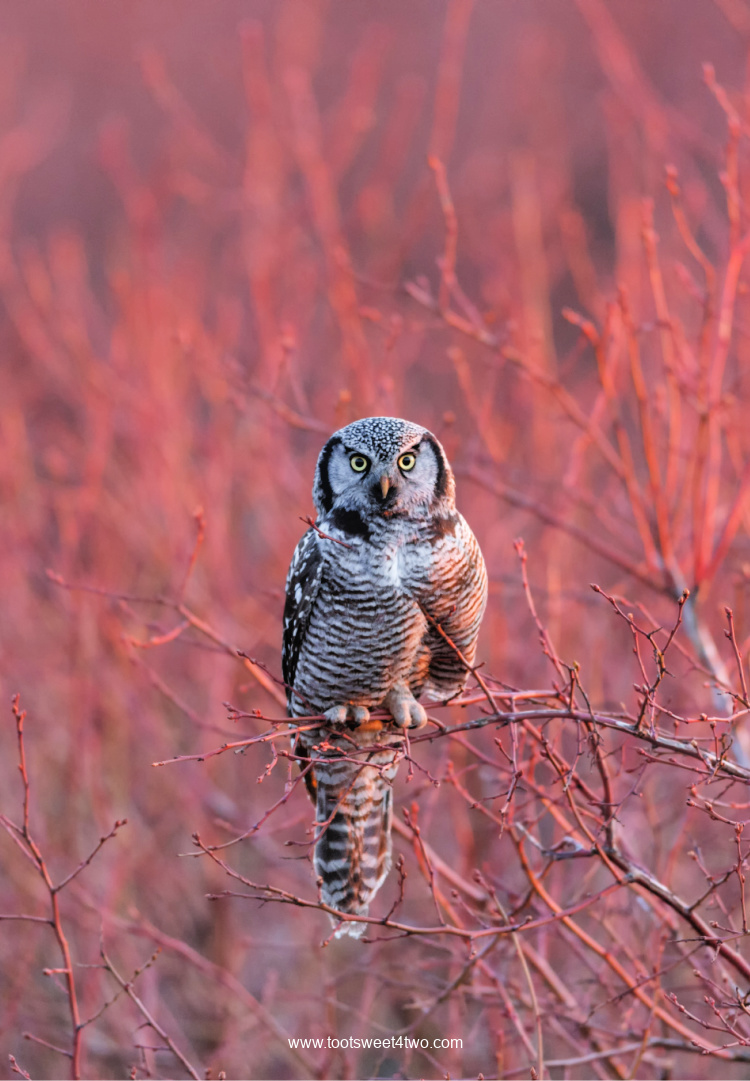
Named for their hawk-like appearance, the Northern Hawk Owl is native to Alaska and across Canada, then on the other side of the pond, they are common in Eurasia, through Siberia, and into Northern China down through Central Asia. With excellent eyesight, the Northern Hawk Owl can spot prey up to one-half mile away. And with excellent hearing, it plunges into the snow in winter to capture prey beneath the surface. Active during the day, its favorite foods are voles and red squirrels and it prefers tundra and sparse forests as opposed to other habitats. With golden eyes and a yellow beak, the Northern Hawk Owl sports a flattish head framed in black. This medium-sized owl has a long, tapered tail and is about 11 inches long, weighs around 11 ounces, and has a wingspan of approximately 30 inches.
#30 – Snowy Owl (Bubo scandiacus)
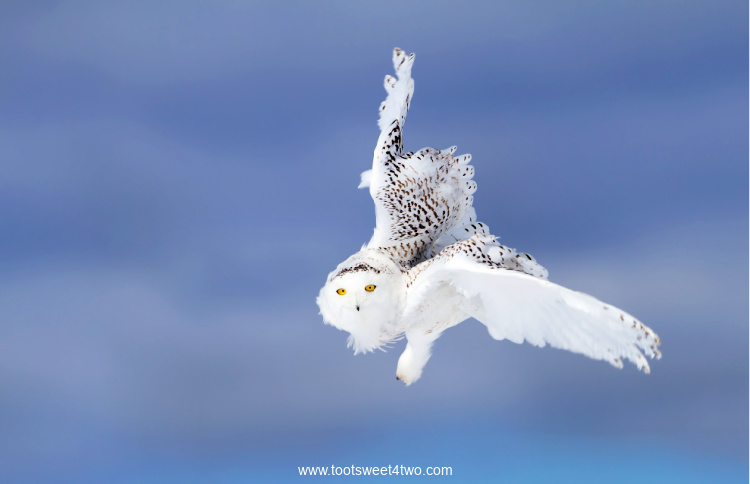
One of the largest owls in the world, the Snowy Owl is also known as Snow Owl, Arctic Owl, Ookpik, and Ukpik. This beautiful white owl lives in the Arctic regions of the world, sometimes migrating south in the winter months into southern Canada, the northern United States, Iceland, Ireland, Scotland, Scandinavia, the Baltics, central Russia, north China, and more. A distinguishing feature in Snowy Owls is that the male is almost pure white and the females are white with dark bars and spots. This leads me to believe that the Snowy Owl in the photo above is female although it takes several years for young male Snowy Owls to turn totally white. Averaging 23 inches in length and weighing as much as 6 1/2 pounds, Snowy Owls have heavily feathered feet, yellow eyes, and a wingspan of about 5 feet. Mostly silent, they whistle, mew, scream, and vocalize hoo, hooo when interacting with others. They hunt all hours of the day and they are one of the few owl species that actually build their own nests. Living on the tundra, in the meadows, marshes, and dunes of the regions they occupy, they build nests on the ground during the nesting season.
#31 – Buffy Fish Owl (Ketupa ketupu)
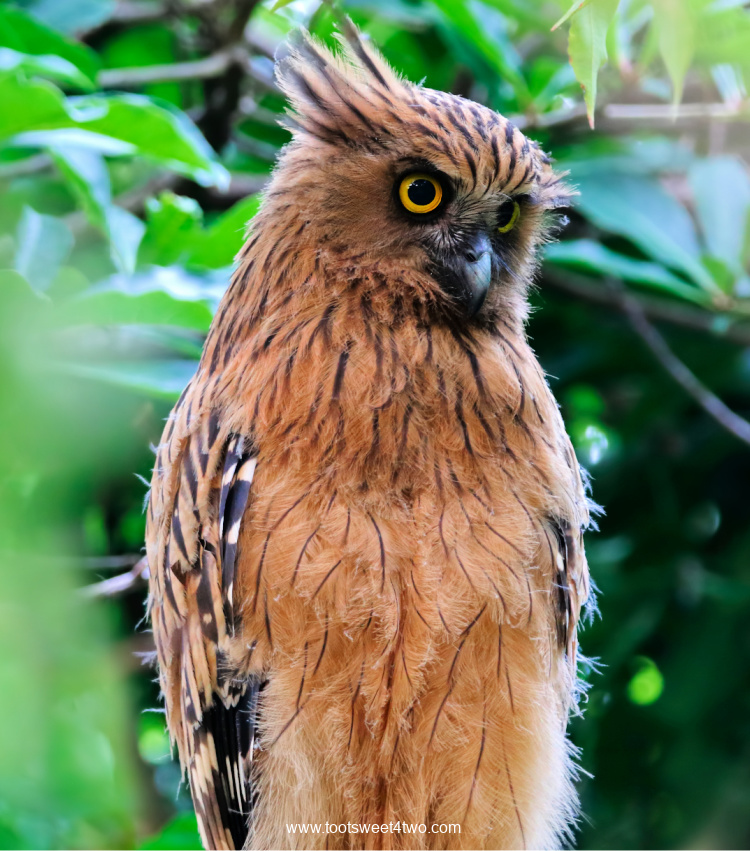
Native to Southeast Asia, the Buffy Fish Owl is also known as the Malay Fish Owl and is the smallest of the fish owl species. With yellow eyes and prominent ear tufts jutting out from the sides of their heads, these distinctive owls are a lovely buff color with darker tawny feathers on their backsides. A large owl, they weigh about 3 1/2 pounds, measure around 18 inches in length and have a wingspan of approximately 30 inches. Living in tropical forests near water and freshwater wetlands, they prey on fish, frogs, reptiles, and the like. How they capture prey is a bit unique for owls – they either walk into shallow streams to catch prey or, perched in a tree near the water’s edge, they swoop down skimming the water’s surface and plucking prey right out of the water with their talons. Interestingly, the Buffy Fish Owl doesn’t like to get wet, so when hunting in water, they do whatever is needed to avoid wetting their feathers.
#32 – Little Owl (Athene noctua)
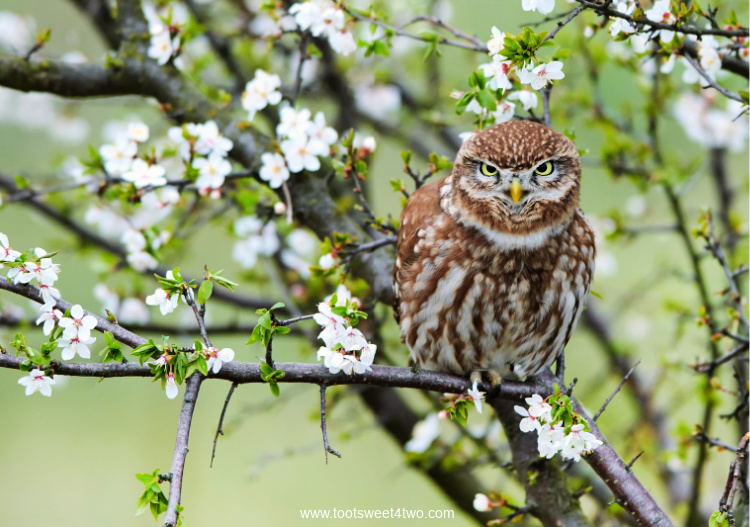
With a chubby body and flat-ish head, the Little Owl is further distinguished by its lack of ear tufts and prominent white eyebrows. Various shades of brown with white spots all over their heads, chests, and backs, these adorable tiny owls are about 8 inches in length, weigh less than 6 ounces, and have an average wingspan of about 22 inches. Found throughout Europe, Asia, and North Africa, the Little Owl chooses to live in a wide variety of habitats – woodland edges, farmland, parks, gardens, open countryside, steppes, semi-desert landscapes, and more. Territorial, it is not unusual that they often occupy an area for life. Often found perching on fence posts, rocky outcrops, farm equipment, and stone walls, they eat a varied diet of all things small – insects, frogs, earthworms, birds, and mammals. A very chatty owl, up to 40 different vocalizations have been identified to this small wonder. Another heart-warming bit of trivia about the Little Owl – mates are known to sleep together and preen each other.
#33 – Australian Masked Owl (Tyto novaehollandiae)
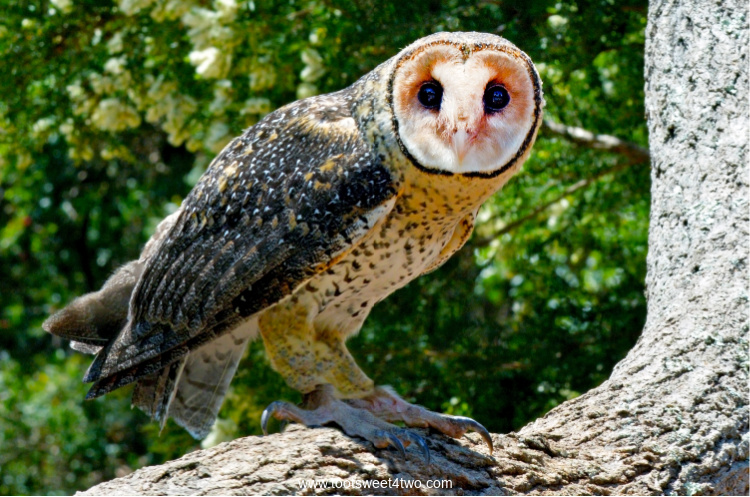
The Australian Masked Owl is a species of Barn Owl, living primarily on the coastal areas of Australia and Southern New Guinea. Also known as the Mouse Owl (because they prey on mice) and the Cave Owl (because they sometimes roost in caves), this large owl weighs between 1 and 2 pounds, is about 15 inches in length, and has a wingspan around 50 inches. With the classic heart-shaped barn owl face and dark brown or black eyes, these owls have three color combinations identified as pale, intermediate, and dark. These color morphs range from various shades of brown and gray to grayish-brown and their facial discs range in color from white to chestnut. Territorial creatures with a loud screeching voice, their typical habitat is open woodland, timbered waterways, forests, swamps, and other areas of dense foliage. Like most owls, they prey on a variety of small mammals, birds, and lizards.
#34 – Blakiston’s Fish Owl (Bubo blakistoni and Ketupa blakistoni)
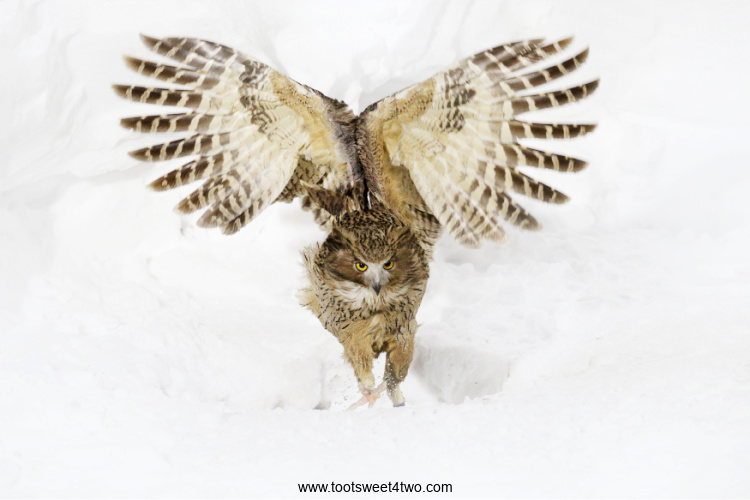
Both the rarest (as in endangered) and the largest owl in the world, the Blakiston’s Fish Owl is also known as Blakiston’s Eagle Owl. It also has the distinction of two classifications because ornithologists/taxon0mists are not in agreement based on recent DNA studies. Inhabiting dense old-growth forests near water sources that don’t freeze in winter, such as fast-moving rivers and streams, as well as wooded coastlines including lakes, their range is the Russian Far East and includes Japan. With yellow eyes, ear tufts that hang on the sides of their heads, and a long beak designed for fishing, this beautiful buff-brown colored owl weighs up to 10 pounds, is around 28 inches in length with a wingspan exceeding 6 feet. They hunt along rivers and streams, spending much of their time on the ground, wading in river shallows, and perching on river banks or logs, waiting patiently for prey. While fish is their desired diet, they do eat small mammals.
#35 – Oriental Bay Owl (Phodilus badius)
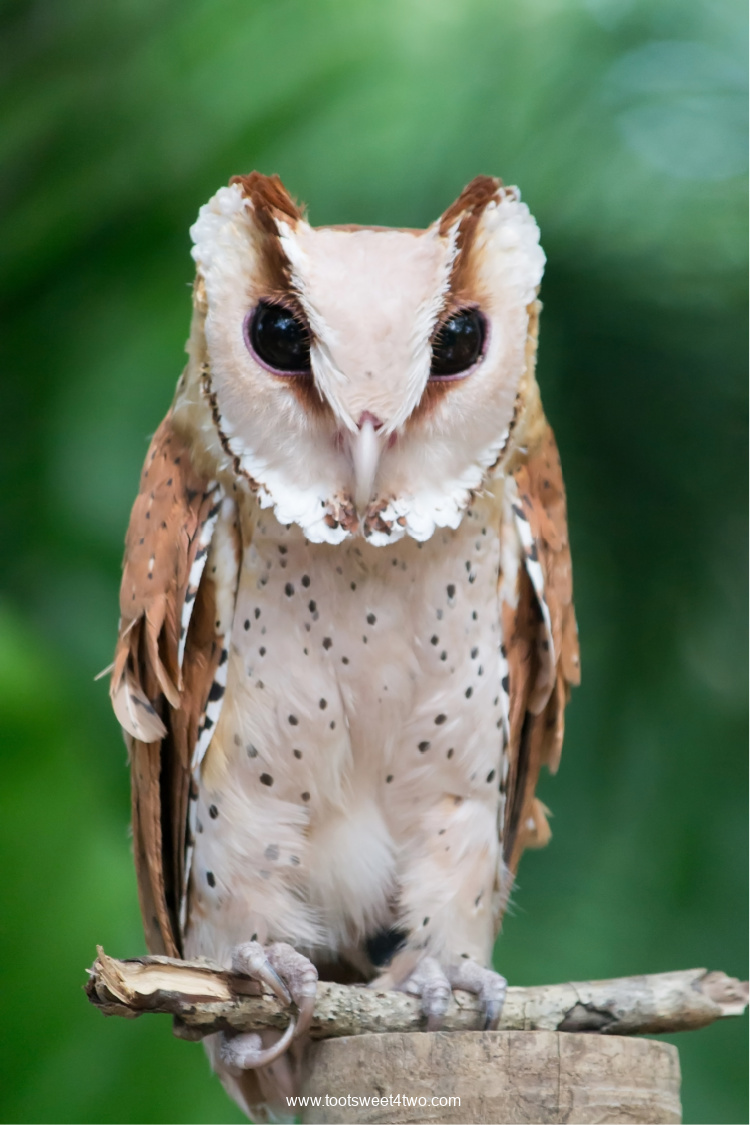
Also known as the Asian Bay Owl, the Oriental Bay Owl is a most peculiar small owl with short wings, short legs, and short ear tufts projecting from the side of its very angular, elongated, heart-shaped head. Rare, there is not much information available about these unusual-looking owls. Native to Southeast Asia, their habitat is dense forest and foothills and they typically roost about 6 feet from the forest floor in holes in tree trunks. Completely nocturnal, they are about 9 inches in length, weigh about 9 ounces, and have a wingspan of approximately 15 inches. They prey on small rodents and large insects within the dense forest canopy in which they live where having shorter wings than most owls is a blessing.
#36 – Barking Owl (Ninox connivens)
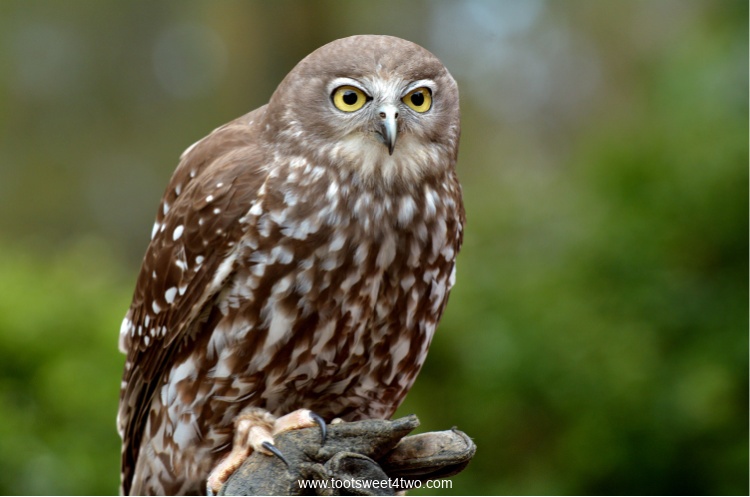
The Barking Owl, also known as the Winking Owl, gets his name from its dog-like woof-woof vocalization. On occasion, it also produces a life-like blood-curdling scream that will wake the dead! A medium-sized hawk owl, it averages 16 inches in length, weighs between 1 and 2 pounds, and has a wingspan of around 45 inches. In this species, the male is usually larger than the female, which is unusual in most owl species. And, another unusual trait is that they are, quite often, found in pairs. Native to Australia, Papua New Guinea, and the Moluccas, it lives in open woodlands, the edges of forests adjacent to farmland near waterways, wetlands, creeks, and rivers roosting mainly in isolated strands of eucalyptus trees. Grey-brown in color with white spots and vertical streaking on its chest, the Barking Owl has yellow eyes and no ear tufts. Not particularly picky about their diet, they hunt small and medium-sized mammals, birds, reptiles, and insects.
#37 – Collared Owlet (Glaucidium brodiei)
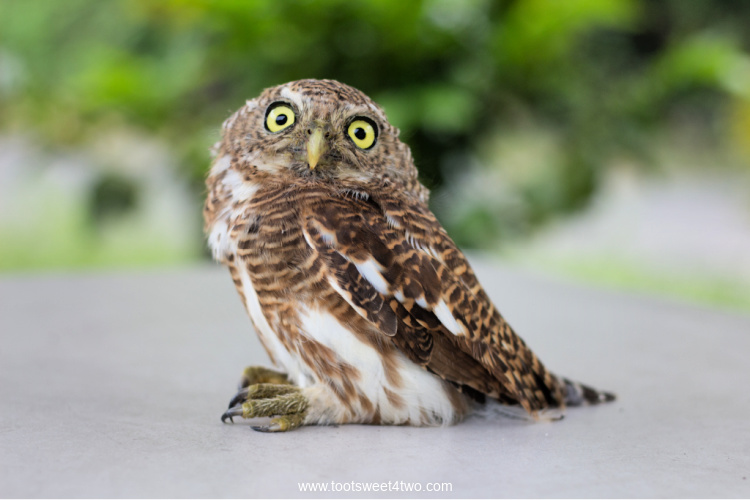
The Collared Owlet, a tiny owl weighing less than 2 ounces and less than 6 inches in length with a wingspan of about 8 inches, is also known as the Collared Pygmy Owl. Native to various countries in Asia, this tiny owl resides in evergreen forests and open woodlands. Active during the day, it preys on small birds, mice, lizards, beetles, and grasshoppers. With no ear tufts, this gray-brown owl sports white eyebrows, yellow eyes, a spotted head with two black spots on the back of its neck known as the “occipital face” or “false eyes.” This little cutey is known for singing a pleasant whistle while bobbing its head from side to side.
#38 – Pueo (Asio flammeus sandwichensis)
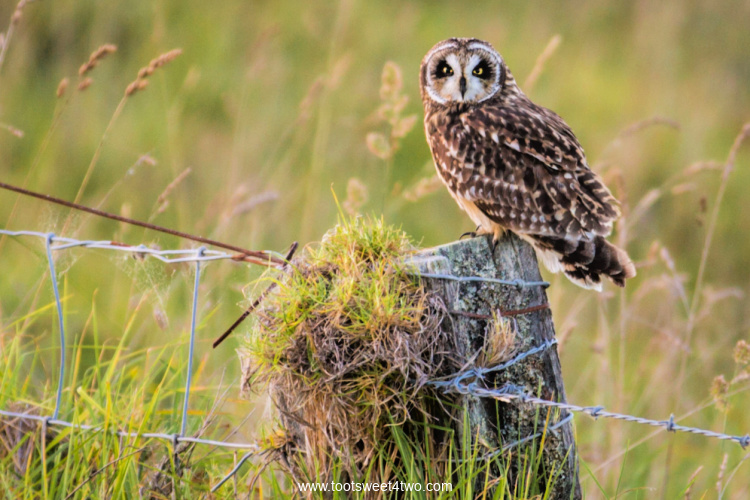
The Pueo, also known as the Hawaiian Short-eared Owl, is a subspecies of the Short-eared Owl. Found only in Hawai’i and present in all the Hawaiian Islands, they are endangered and elusive. Revered as ancestral guardians that protect families from harm, males court females with sky dancing (aerial acrobatics with wing clapping). With a white frame circling their facial disc and piercing yellow eyes, this beautiful owl is mottled brown in color and has a distinguishing white X across its face. Active during the day, they hunt small mammals, small birds, and insects by hovering over their prey, folding their wings close to their bodies, and diving. One of the few owls that build their own nests (in the ground), their favored habitats include parklands, grasslands, shrublands, and both wet and dry forests.
#39 – White-fronted Scops Owl (Otus sagittatus)
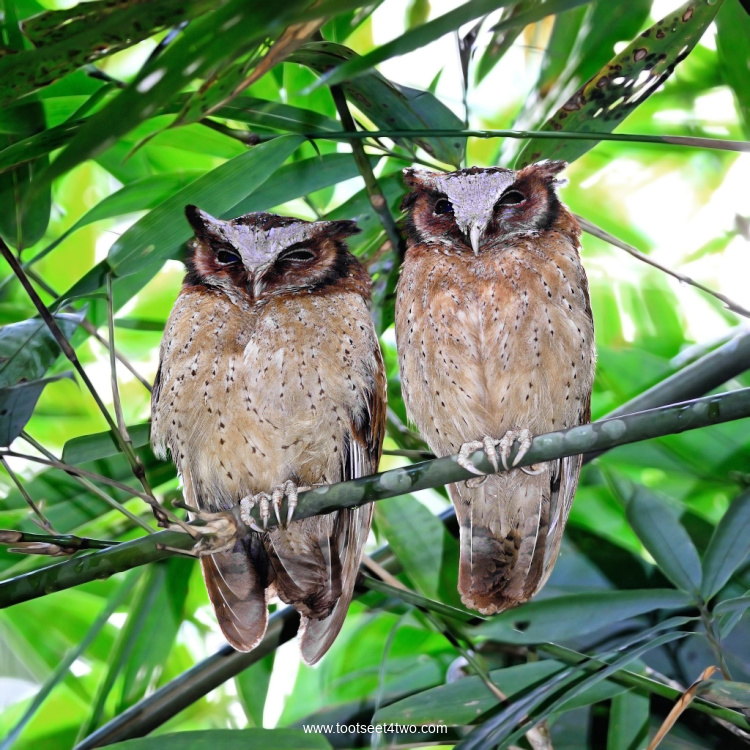
A rare, elusive bird that lives in lowland rainforests and jungles in the Thai-Malay Peninsula, the White-faced Scops Owl is considered “vulnerable” with a declining population. A large owl, it weighs about 4 pounds, is approximately 10 inches in length with a wingspan of around 15 inches. It is easily recognizable by its prominent white triangular forehead and large ear tufts that splay out over the sides of its head. It feeds primarily on insects, preferring moths, and can triple the appearance of its body size, when it feels threatened, by puffing up its feathers.
#40 – Lesser Sooty Owl (Tyto multipunctata)

The Lesser Sooty Owl, also known as the Silver Owl, is part of the Barn Owl family Tyto. Native to Northeastern Australia, their habitat is the tropical rainforests of that region. Considered a medium-sized owl, they are 15 inches in length, weigh around a pound, and have a wingspan of approximately 20 inches. With the classic Barn Owl heart-shaped face, this beautiful owl has dark “sooty” eyes rimmed in sooty feathers, giving this owl the appearance of eyelashes, and has a white-ish or pale gray silvery facial disc. Even their beaks are some shade of gray! Strictly nocturnal, they hunt mostly small mammals, a few insects, and some birds. One of their vocalizations, a whistle, has been described as a “dropping bomb call” and a “bomb whistle.”
#41 – Brown Fish Owl (Keputa zeylonensis)
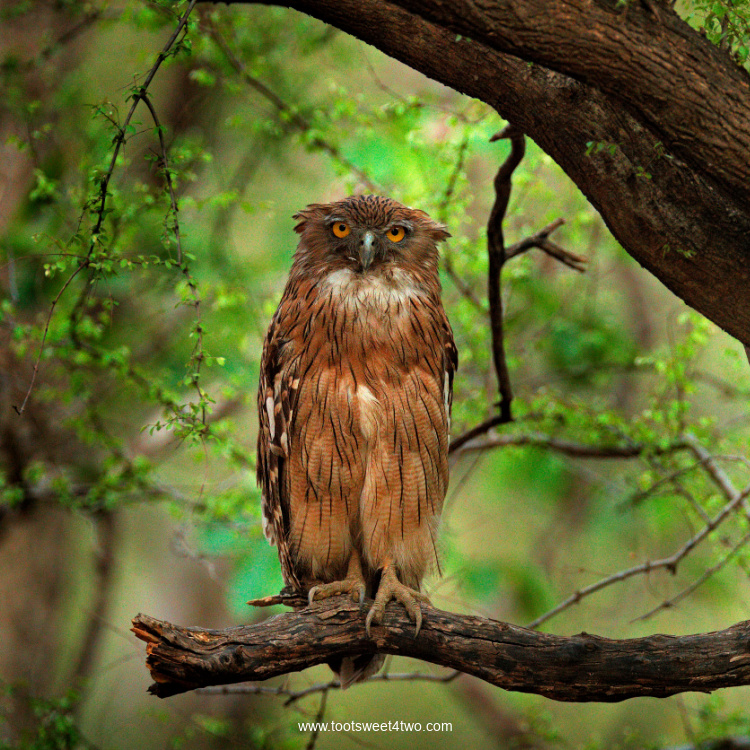
Another large owl, the Brown Fish Owl weighs about 4 pounds, is around 21 inches in length, and has a wingspan of approximately 52 inches. With bushy ears tufts that lay horizontally on their heads, golden-yellow eyes, and featherless yellow feet, the Brown Fish Owl is multiple shades of brown ranging from chestnut brown to rufous-brown with mottled dark and white feathers. Unlike most owls, the Brown Fish Owl is not soft to the touch. Found in lowland forests always near a body of water, these owls are native to Sri Lanka, India, Thailand, Myanmar, Turkey, Iran, Pakistan, Vietnam, Southeastern China, and Hainan Island. Perching on a stump or rock near water, they hunt prey by flying back and forth skimming the top of the body of water to scoop up their prey, which is mostly fish, crabs, and frogs.
#42 – Collared Scops Owl (Otus lettia)
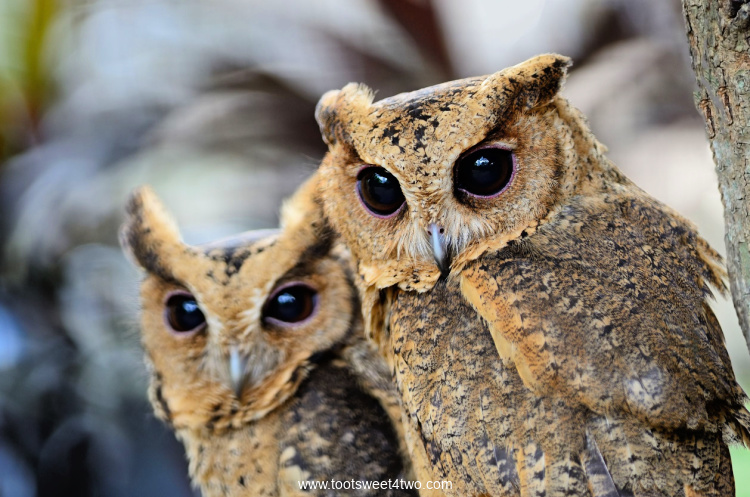
The last owl in this list of 42 types of owls, the Collared Scops Owl is native to South Asia, northern Pakistan, northern India, and the Himalayas east to Burma, Thailand, South China, and Taiwan. A small owl with large ear tufts and dark eyes, its coloring ranges from gray-brown to rust (rufous morph) with pale neckbands, i.e., collars (thus the name). Inhabiting forests and other wooded areas, it is very similar in appearance to both the Oriental Scops Owl and the Indian Scops Owl. About 9 inches, weighing around 5 ounces with a wingspan of approximately 15 inches, it eats mostly insects, primarily beetles, and grasshoppers.
Aren’t each and every one of these owls beauties in their own way? Using the generally accepted number of owls in the world, 216, as our basis, that means there are 174 more owls out there for you to identify, research, and explore. Many species are elusive, so sightings are rare, and photos non-existent. A bucket list project, for sure, attempting to see even a small number of these amazing creatures is an undertaking, so I feel especially blessed to have seen 4 different ones in my own back yard.
Gift Ideas for Owl Lovers
Know an owl lover? I’ve curated several different gift ideas with an owl theme for you! Here are links, in no particular order:
Stuffed Owls – whoo knew there were so many choices of adorable stuffed owls in all sizes?
Owl Decorative Throw Pillows – so many choices, how do you choose?
Owl Blankets and Throws – coziness never felt so good!
Owl Decor – owl planters, owl figurines, owl vases, owl prints, owl garden lights, and more!
Owl Kitchen Decor – owl kitchen towels, owl pot holders, owl canisters, and more!
Owl Coffee Mugs – need I say more?
Owl Jewelry – owl earrings, owl necklaces, owl bracelets, and more!
Owl Clothing – owl socks, owl jammies, owl T-shirts, and more!
Owl Baby Items – so many cute things!
Owl Books – too many to choose just one!
Owl Toys – owl games, owl puzzles, even a storytelling owl!
Owl Party Supplies – owl birthday parties, owl gender reveal parties or just owl appreciation parties!
I’m sure I’ve left something out!

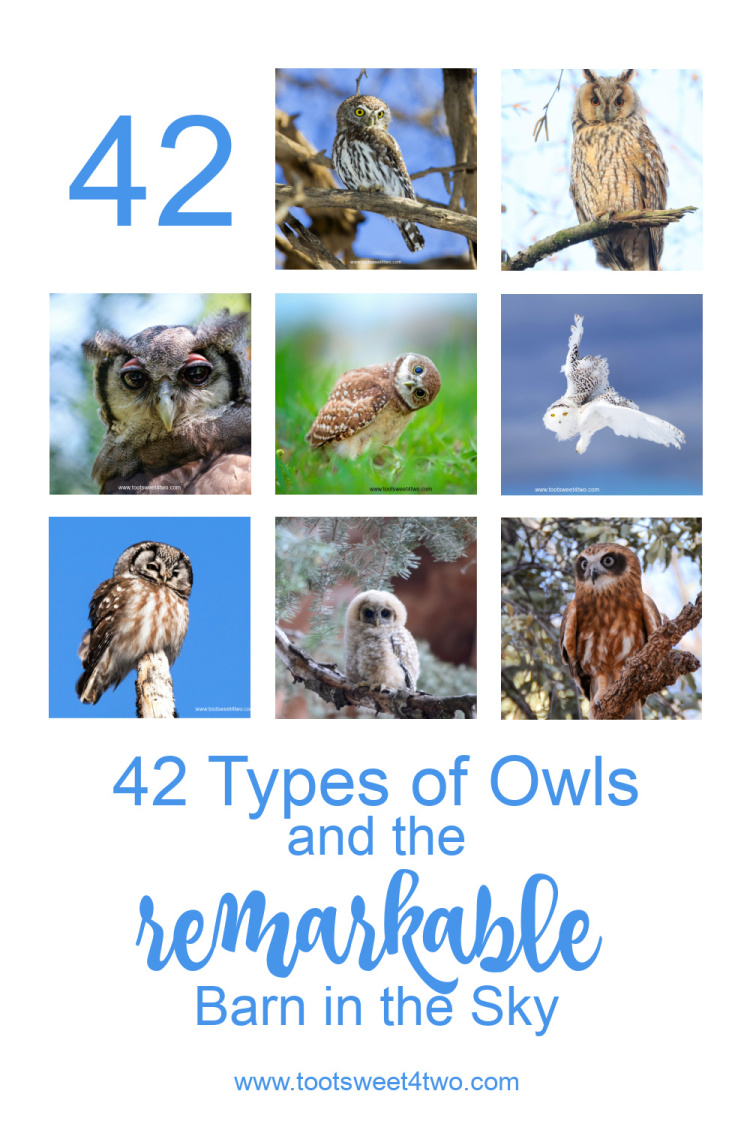
Will you do me a favor? Would you share my post on social media? The pinnable images scattered throughout this post are for your Pinterest boards so that you can bookmark this post and come back to it later. Thanks for sharing!
And don’t forget to sign up to receive my newsletter in your inbox. As a thank you, I’ll send you a freebie – Owl Lovers’ Activity Book: 42 Games, Puzzles, and Coloring Pages for Hours of Fun! Look for the sign-up boxes near the top of this post and again at the bottom of this post. Thanks so much!
Tootles,

Related Posts from Toot Sweet 4 Two’s Archives
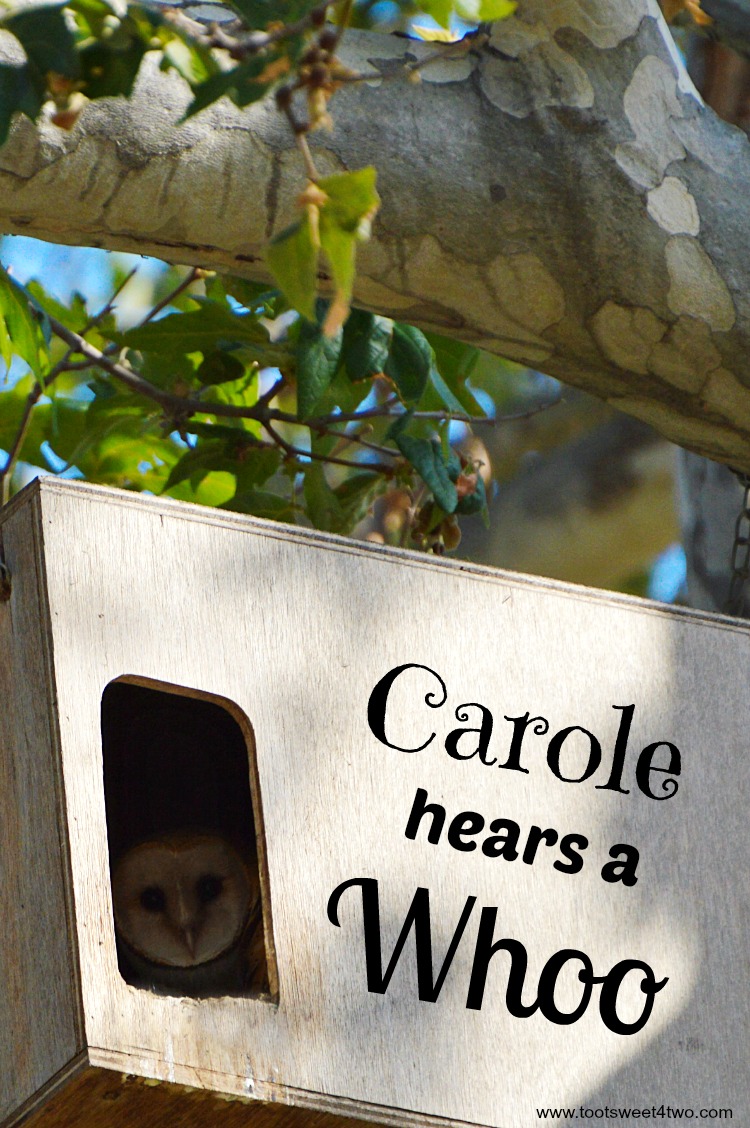
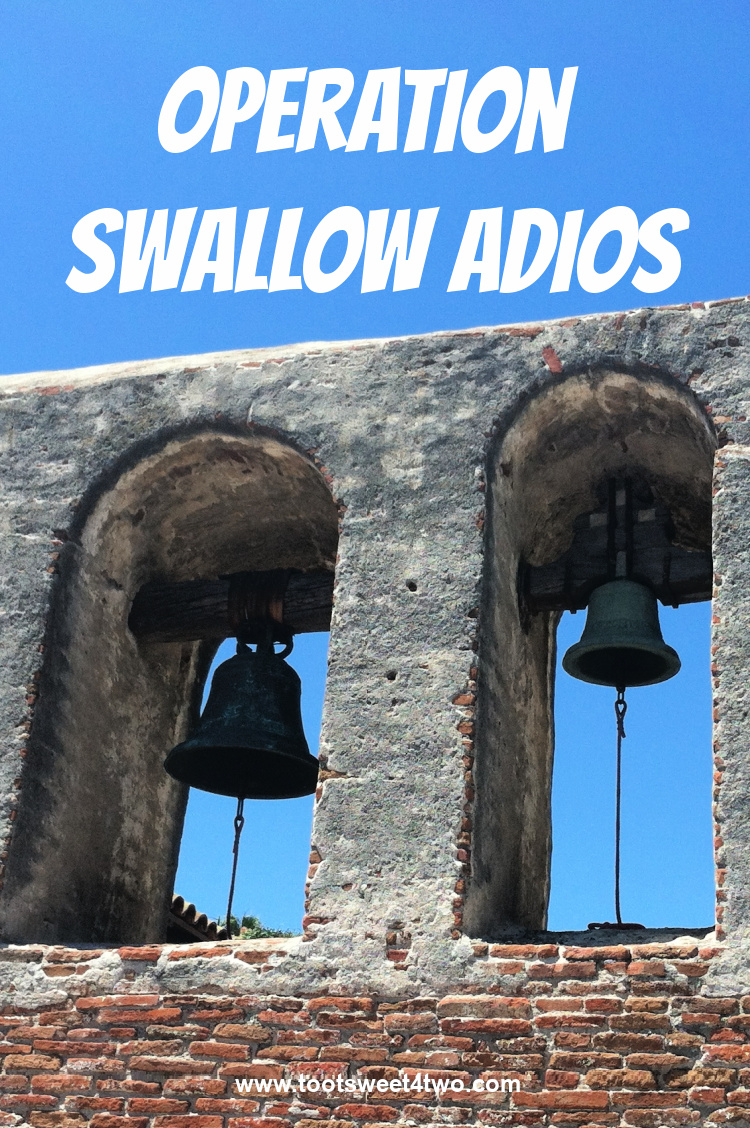
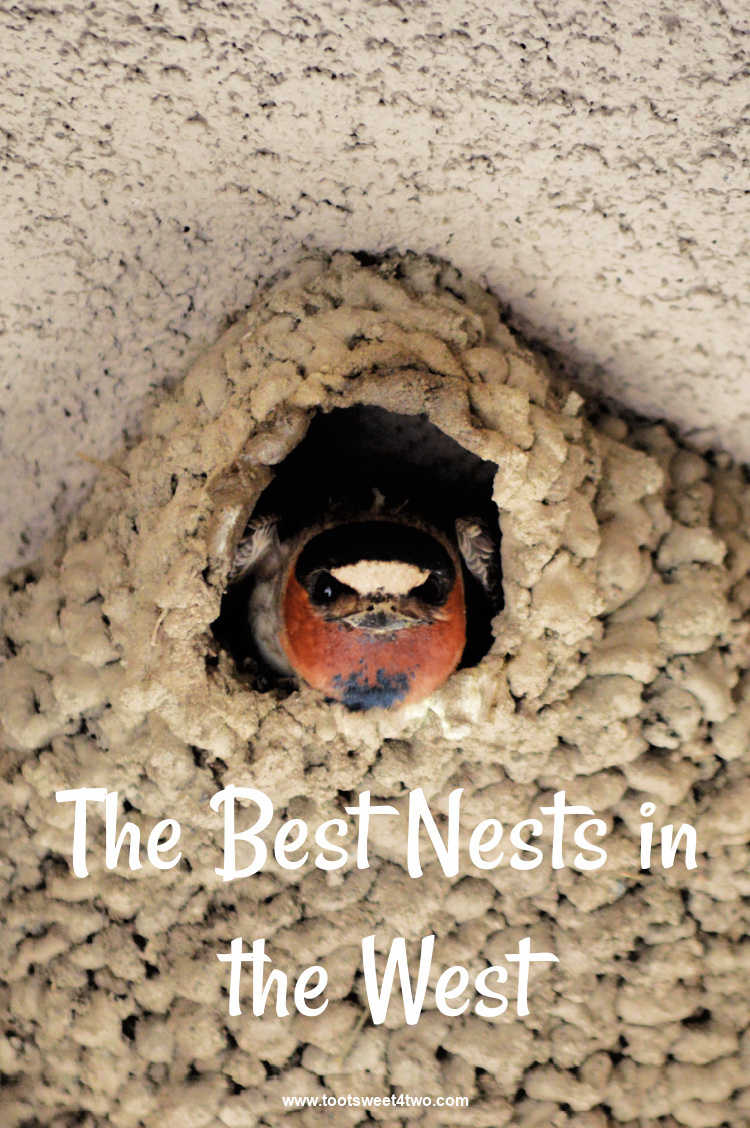
You Might Also Like:
Build a Barn Owl Box by the Santa Clara Valley Audubon Society (includes a downloadable PDF)
How to Build a Screech-Owl Nest Box by the Audubon Society
How to Build an Owl Box by Justin Cox at UC Davis
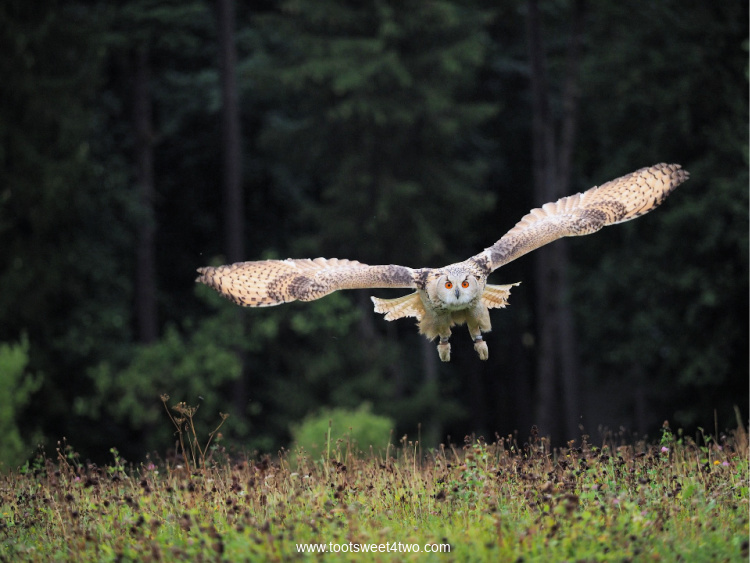
Leave a Reply